Recruiting, Retaining and Promoting Culturally Different Employees
VerifiedAdded on 2019/12/03
|19
|6285
|163
Report
AI Summary
This assignment content discusses various topics related to human resource management, learning, education, and training. It includes texts from different authors and sources, including books, journals, and online articles. The topics covered include culturally different employees, employee development, resistance training programs, experiential learning, improving training effectiveness, international human resource development, adult learners, and centralized simulation training. The content also touches on equality in the workplace and the role of HR management in achieving sustainable organizations.
Contribute Materials
Your contribution can guide someone’s learning journey. Share your
documents today.
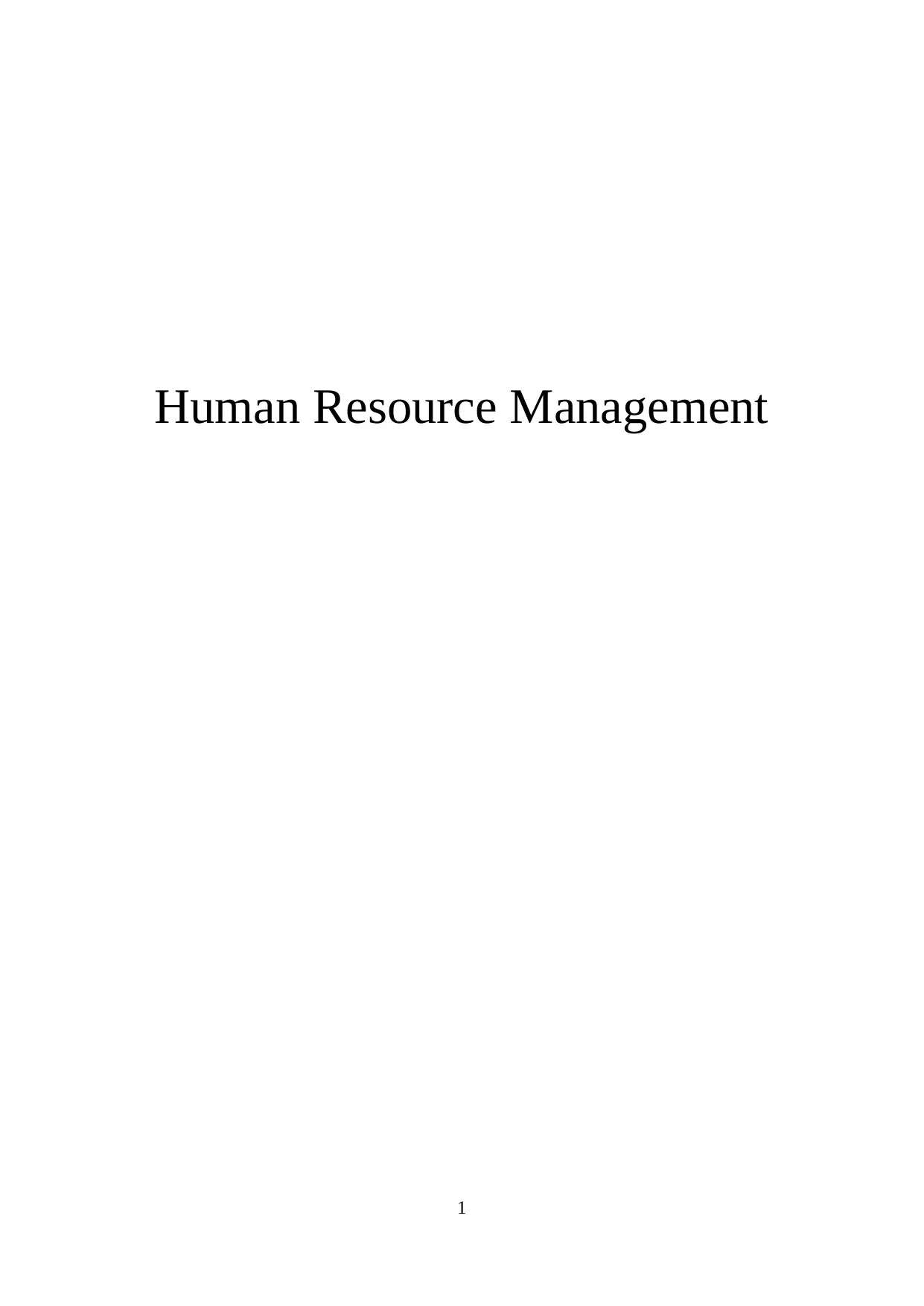
Human Resource Management
1
1
Secure Best Marks with AI Grader
Need help grading? Try our AI Grader for instant feedback on your assignments.
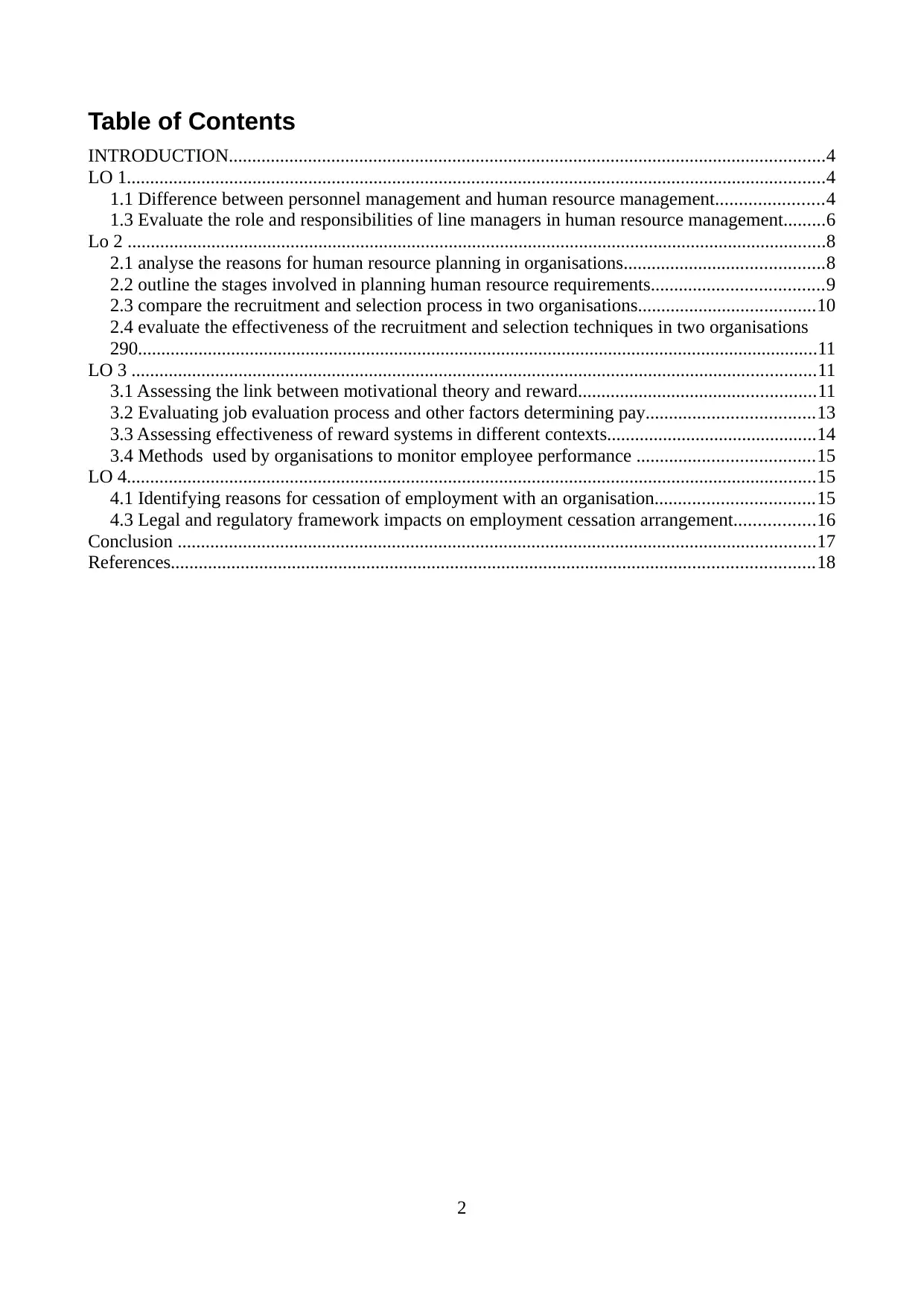
Table of Contents
INTRODUCTION................................................................................................................................4
LO 1......................................................................................................................................................4
1.1 Difference between personnel management and human resource management.......................4
1.3 Evaluate the role and responsibilities of line managers in human resource management.........6
Lo 2 ......................................................................................................................................................8
2.1 analyse the reasons for human resource planning in organisations...........................................8
2.2 outline the stages involved in planning human resource requirements.....................................9
2.3 compare the recruitment and selection process in two organisations......................................10
2.4 evaluate the effectiveness of the recruitment and selection techniques in two organisations
290..................................................................................................................................................11
LO 3 ...................................................................................................................................................11
3.1 Assessing the link between motivational theory and reward...................................................11
3.2 Evaluating job evaluation process and other factors determining pay....................................13
3.3 Assessing effectiveness of reward systems in different contexts.............................................14
3.4 Methods used by organisations to monitor employee performance ......................................15
LO 4....................................................................................................................................................15
4.1 Identifying reasons for cessation of employment with an organisation..................................15
4.3 Legal and regulatory framework impacts on employment cessation arrangement.................16
Conclusion .........................................................................................................................................17
References..........................................................................................................................................18
2
INTRODUCTION................................................................................................................................4
LO 1......................................................................................................................................................4
1.1 Difference between personnel management and human resource management.......................4
1.3 Evaluate the role and responsibilities of line managers in human resource management.........6
Lo 2 ......................................................................................................................................................8
2.1 analyse the reasons for human resource planning in organisations...........................................8
2.2 outline the stages involved in planning human resource requirements.....................................9
2.3 compare the recruitment and selection process in two organisations......................................10
2.4 evaluate the effectiveness of the recruitment and selection techniques in two organisations
290..................................................................................................................................................11
LO 3 ...................................................................................................................................................11
3.1 Assessing the link between motivational theory and reward...................................................11
3.2 Evaluating job evaluation process and other factors determining pay....................................13
3.3 Assessing effectiveness of reward systems in different contexts.............................................14
3.4 Methods used by organisations to monitor employee performance ......................................15
LO 4....................................................................................................................................................15
4.1 Identifying reasons for cessation of employment with an organisation..................................15
4.3 Legal and regulatory framework impacts on employment cessation arrangement.................16
Conclusion .........................................................................................................................................17
References..........................................................................................................................................18
2
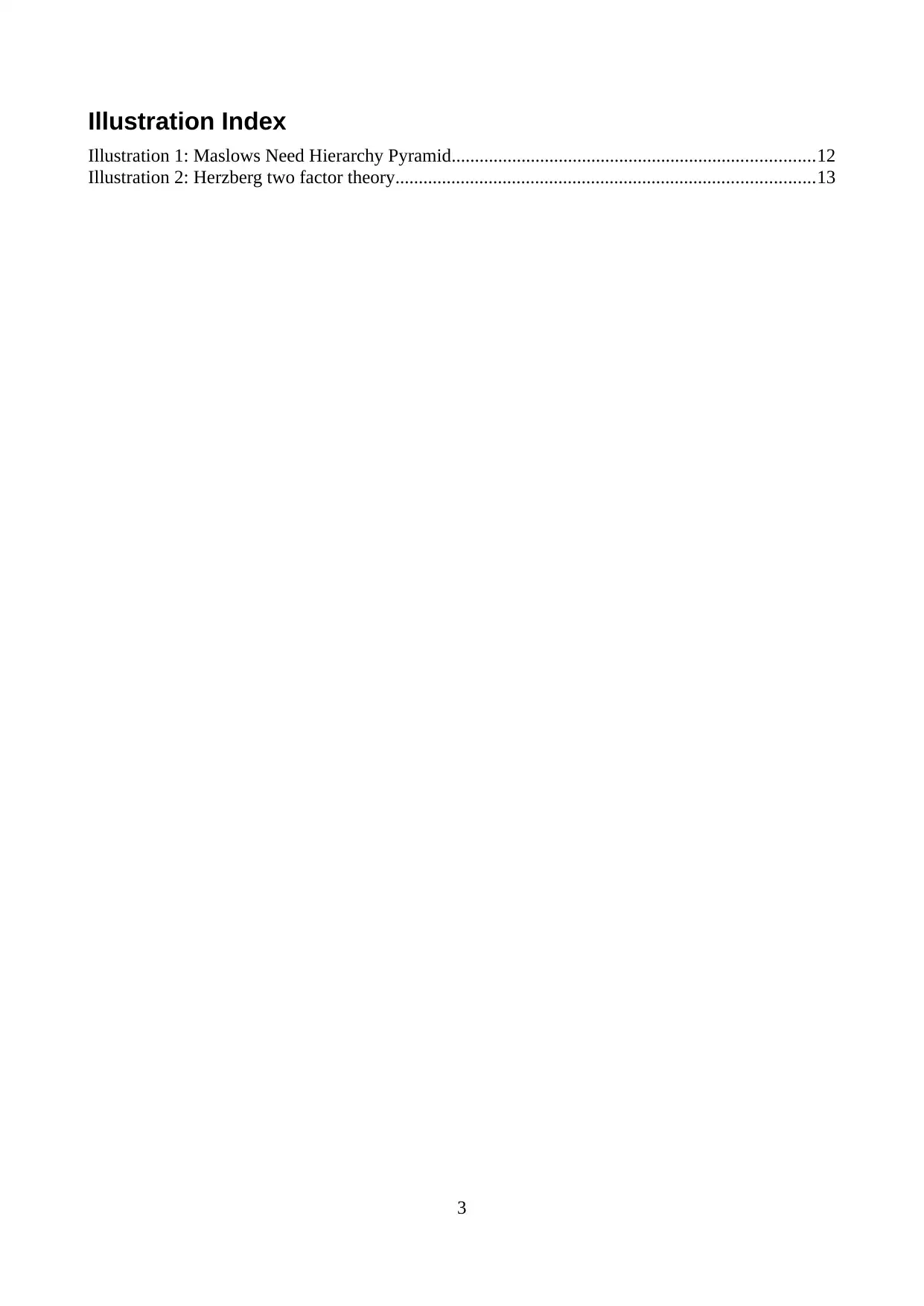
Illustration Index
Illustration 1: Maslows Need Hierarchy Pyramid..............................................................................12
Illustration 2: Herzberg two factor theory..........................................................................................13
3
Illustration 1: Maslows Need Hierarchy Pyramid..............................................................................12
Illustration 2: Herzberg two factor theory..........................................................................................13
3
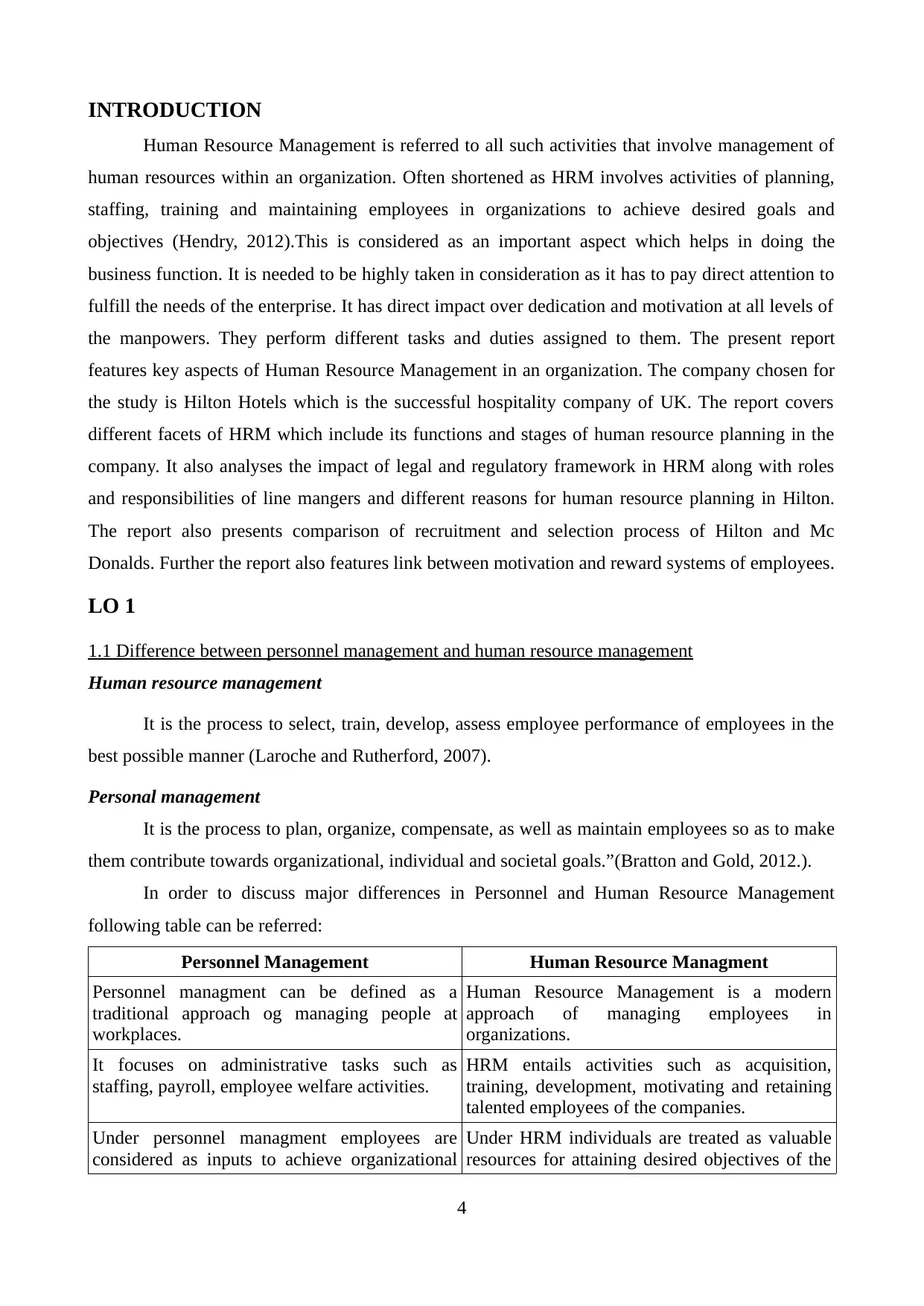
INTRODUCTION
Human Resource Management is referred to all such activities that involve management of
human resources within an organization. Often shortened as HRM involves activities of planning,
staffing, training and maintaining employees in organizations to achieve desired goals and
objectives (Hendry, 2012).This is considered as an important aspect which helps in doing the
business function. It is needed to be highly taken in consideration as it has to pay direct attention to
fulfill the needs of the enterprise. It has direct impact over dedication and motivation at all levels of
the manpowers. They perform different tasks and duties assigned to them. The present report
features key aspects of Human Resource Management in an organization. The company chosen for
the study is Hilton Hotels which is the successful hospitality company of UK. The report covers
different facets of HRM which include its functions and stages of human resource planning in the
company. It also analyses the impact of legal and regulatory framework in HRM along with roles
and responsibilities of line mangers and different reasons for human resource planning in Hilton.
The report also presents comparison of recruitment and selection process of Hilton and Mc
Donalds. Further the report also features link between motivation and reward systems of employees.
LO 1
1.1 Difference between personnel management and human resource management
Human resource management
It is the process to select, train, develop, assess employee performance of employees in the
best possible manner (Laroche and Rutherford, 2007).
Personal management
It is the process to plan, organize, compensate, as well as maintain employees so as to make
them contribute towards organizational, individual and societal goals.”(Bratton and Gold, 2012.).
In order to discuss major differences in Personnel and Human Resource Management
following table can be referred:
Personnel Management Human Resource Managment
Personnel managment can be defined as a
traditional approach og managing people at
workplaces.
Human Resource Management is a modern
approach of managing employees in
organizations.
It focuses on administrative tasks such as
staffing, payroll, employee welfare activities.
HRM entails activities such as acquisition,
training, development, motivating and retaining
talented employees of the companies.
Under personnel managment employees are
considered as inputs to achieve organizational
Under HRM individuals are treated as valuable
resources for attaining desired objectives of the
4
Human Resource Management is referred to all such activities that involve management of
human resources within an organization. Often shortened as HRM involves activities of planning,
staffing, training and maintaining employees in organizations to achieve desired goals and
objectives (Hendry, 2012).This is considered as an important aspect which helps in doing the
business function. It is needed to be highly taken in consideration as it has to pay direct attention to
fulfill the needs of the enterprise. It has direct impact over dedication and motivation at all levels of
the manpowers. They perform different tasks and duties assigned to them. The present report
features key aspects of Human Resource Management in an organization. The company chosen for
the study is Hilton Hotels which is the successful hospitality company of UK. The report covers
different facets of HRM which include its functions and stages of human resource planning in the
company. It also analyses the impact of legal and regulatory framework in HRM along with roles
and responsibilities of line mangers and different reasons for human resource planning in Hilton.
The report also presents comparison of recruitment and selection process of Hilton and Mc
Donalds. Further the report also features link between motivation and reward systems of employees.
LO 1
1.1 Difference between personnel management and human resource management
Human resource management
It is the process to select, train, develop, assess employee performance of employees in the
best possible manner (Laroche and Rutherford, 2007).
Personal management
It is the process to plan, organize, compensate, as well as maintain employees so as to make
them contribute towards organizational, individual and societal goals.”(Bratton and Gold, 2012.).
In order to discuss major differences in Personnel and Human Resource Management
following table can be referred:
Personnel Management Human Resource Managment
Personnel managment can be defined as a
traditional approach og managing people at
workplaces.
Human Resource Management is a modern
approach of managing employees in
organizations.
It focuses on administrative tasks such as
staffing, payroll, employee welfare activities.
HRM entails activities such as acquisition,
training, development, motivating and retaining
talented employees of the companies.
Under personnel managment employees are
considered as inputs to achieve organizational
Under HRM individuals are treated as valuable
resources for attaining desired objectives of the
4
Secure Best Marks with AI Grader
Need help grading? Try our AI Grader for instant feedback on your assignments.
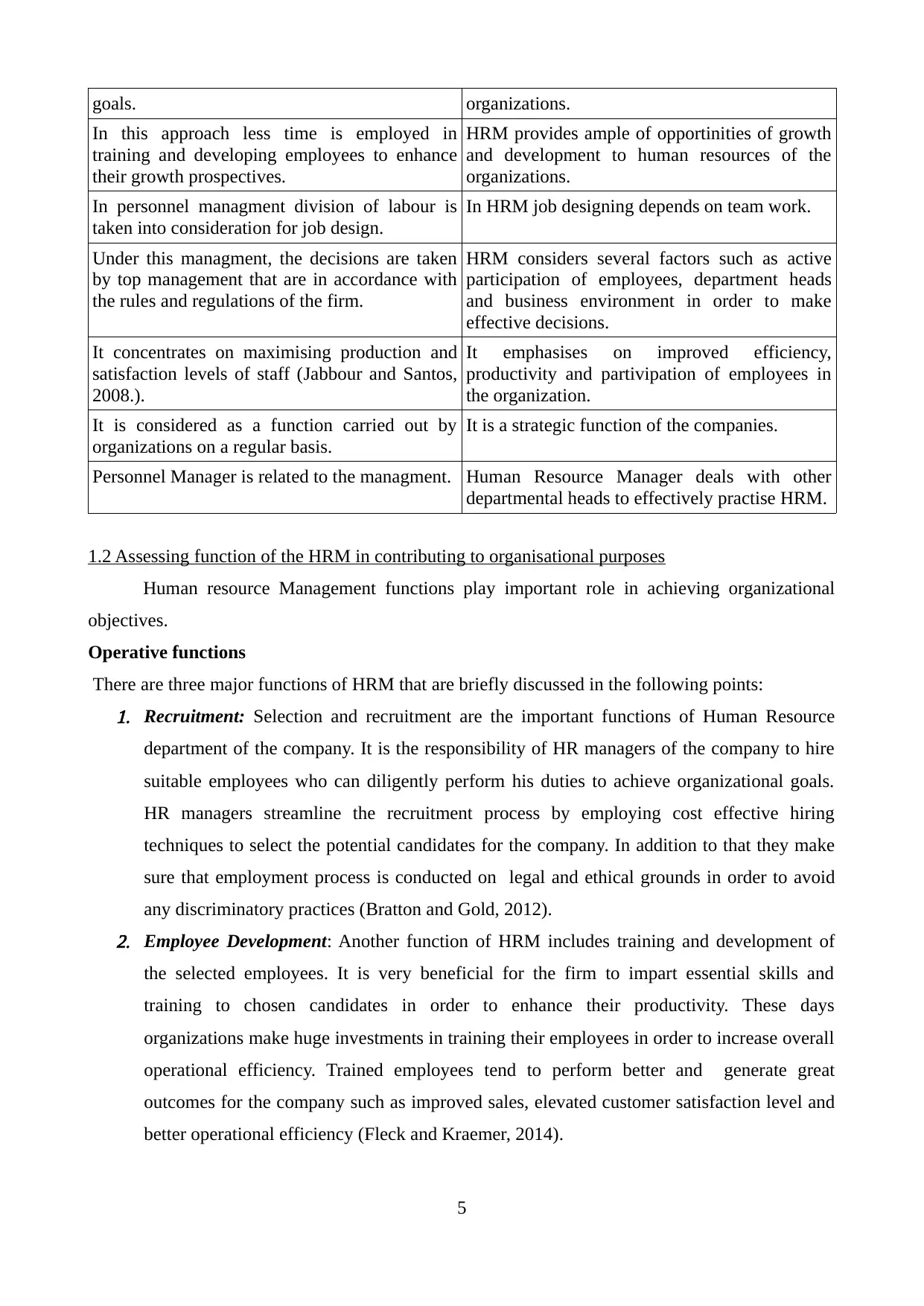
goals. organizations.
In this approach less time is employed in
training and developing employees to enhance
their growth prospectives.
HRM provides ample of opportinities of growth
and development to human resources of the
organizations.
In personnel managment division of labour is
taken into consideration for job design.
In HRM job designing depends on team work.
Under this managment, the decisions are taken
by top management that are in accordance with
the rules and regulations of the firm.
HRM considers several factors such as active
participation of employees, department heads
and business environment in order to make
effective decisions.
It concentrates on maximising production and
satisfaction levels of staff (Jabbour and Santos,
2008.).
It emphasises on improved efficiency,
productivity and partivipation of employees in
the organization.
It is considered as a function carried out by
organizations on a regular basis.
It is a strategic function of the companies.
Personnel Manager is related to the managment. Human Resource Manager deals with other
departmental heads to effectively practise HRM.
1.2 Assessing function of the HRM in contributing to organisational purposes
Human resource Management functions play important role in achieving organizational
objectives.
Operative functions
There are three major functions of HRM that are briefly discussed in the following points:1. Recruitment: Selection and recruitment are the important functions of Human Resource
department of the company. It is the responsibility of HR managers of the company to hire
suitable employees who can diligently perform his duties to achieve organizational goals.
HR managers streamline the recruitment process by employing cost effective hiring
techniques to select the potential candidates for the company. In addition to that they make
sure that employment process is conducted on legal and ethical grounds in order to avoid
any discriminatory practices (Bratton and Gold, 2012).2. Employee Development: Another function of HRM includes training and development of
the selected employees. It is very beneficial for the firm to impart essential skills and
training to chosen candidates in order to enhance their productivity. These days
organizations make huge investments in training their employees in order to increase overall
operational efficiency. Trained employees tend to perform better and generate great
outcomes for the company such as improved sales, elevated customer satisfaction level and
better operational efficiency (Fleck and Kraemer, 2014).
5
In this approach less time is employed in
training and developing employees to enhance
their growth prospectives.
HRM provides ample of opportinities of growth
and development to human resources of the
organizations.
In personnel managment division of labour is
taken into consideration for job design.
In HRM job designing depends on team work.
Under this managment, the decisions are taken
by top management that are in accordance with
the rules and regulations of the firm.
HRM considers several factors such as active
participation of employees, department heads
and business environment in order to make
effective decisions.
It concentrates on maximising production and
satisfaction levels of staff (Jabbour and Santos,
2008.).
It emphasises on improved efficiency,
productivity and partivipation of employees in
the organization.
It is considered as a function carried out by
organizations on a regular basis.
It is a strategic function of the companies.
Personnel Manager is related to the managment. Human Resource Manager deals with other
departmental heads to effectively practise HRM.
1.2 Assessing function of the HRM in contributing to organisational purposes
Human resource Management functions play important role in achieving organizational
objectives.
Operative functions
There are three major functions of HRM that are briefly discussed in the following points:1. Recruitment: Selection and recruitment are the important functions of Human Resource
department of the company. It is the responsibility of HR managers of the company to hire
suitable employees who can diligently perform his duties to achieve organizational goals.
HR managers streamline the recruitment process by employing cost effective hiring
techniques to select the potential candidates for the company. In addition to that they make
sure that employment process is conducted on legal and ethical grounds in order to avoid
any discriminatory practices (Bratton and Gold, 2012).2. Employee Development: Another function of HRM includes training and development of
the selected employees. It is very beneficial for the firm to impart essential skills and
training to chosen candidates in order to enhance their productivity. These days
organizations make huge investments in training their employees in order to increase overall
operational efficiency. Trained employees tend to perform better and generate great
outcomes for the company such as improved sales, elevated customer satisfaction level and
better operational efficiency (Fleck and Kraemer, 2014).
5
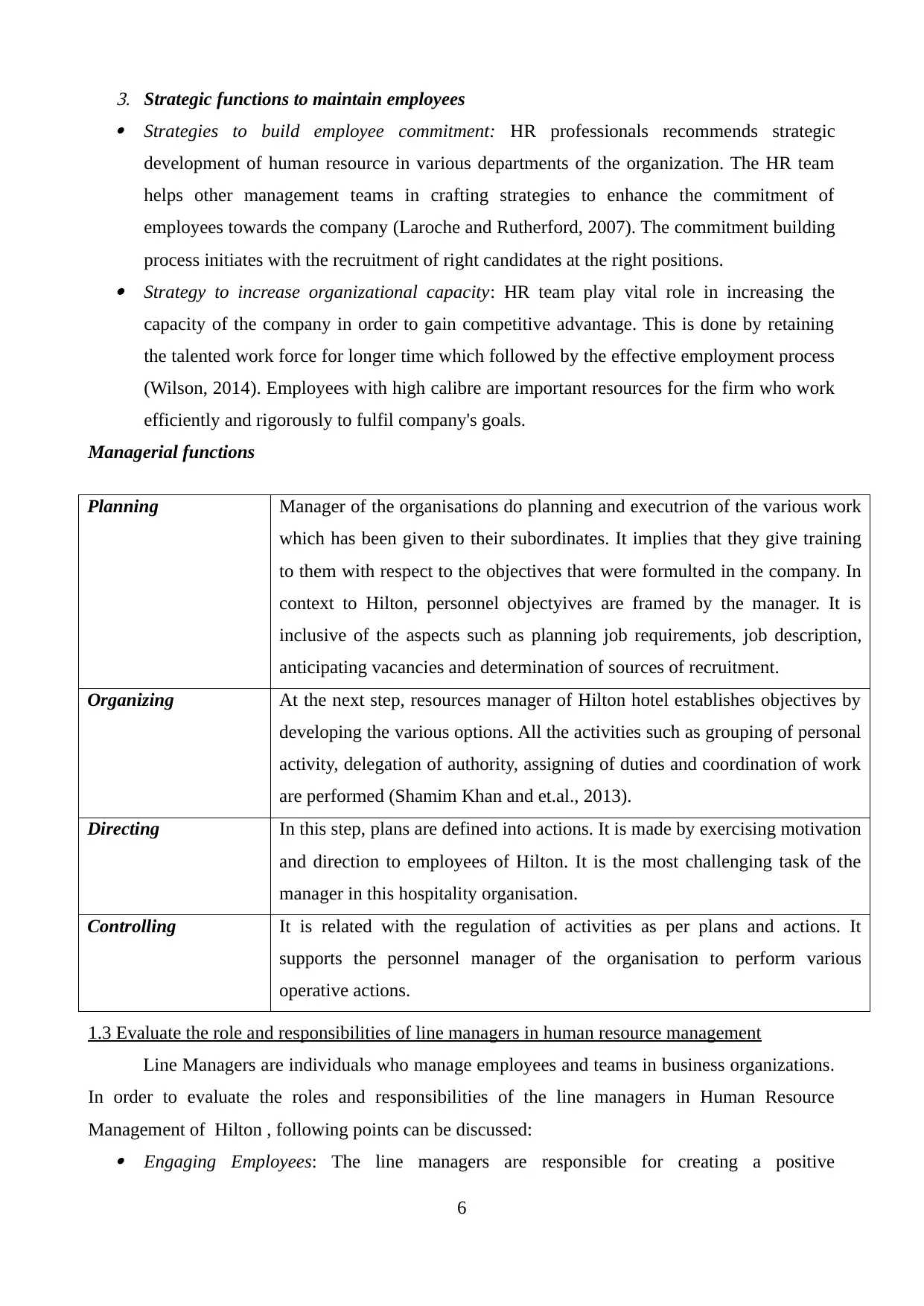
3. Strategic functions to maintain employees Strategies to build employee commitment: HR professionals recommends strategic
development of human resource in various departments of the organization. The HR team
helps other management teams in crafting strategies to enhance the commitment of
employees towards the company (Laroche and Rutherford, 2007). The commitment building
process initiates with the recruitment of right candidates at the right positions. Strategy to increase organizational capacity: HR team play vital role in increasing the
capacity of the company in order to gain competitive advantage. This is done by retaining
the talented work force for longer time which followed by the effective employment process
(Wilson, 2014). Employees with high calibre are important resources for the firm who work
efficiently and rigorously to fulfil company's goals.
Managerial functions
Planning Manager of the organisations do planning and executrion of the various work
which has been given to their subordinates. It implies that they give training
to them with respect to the objectives that were formulted in the company. In
context to Hilton, personnel objectyives are framed by the manager. It is
inclusive of the aspects such as planning job requirements, job description,
anticipating vacancies and determination of sources of recruitment.
Organizing At the next step, resources manager of Hilton hotel establishes objectives by
developing the various options. All the activities such as grouping of personal
activity, delegation of authority, assigning of duties and coordination of work
are performed (Shamim Khan and et.al., 2013).
Directing In this step, plans are defined into actions. It is made by exercising motivation
and direction to employees of Hilton. It is the most challenging task of the
manager in this hospitality organisation.
Controlling It is related with the regulation of activities as per plans and actions. It
supports the personnel manager of the organisation to perform various
operative actions.
1.3 Evaluate the role and responsibilities of line managers in human resource management
Line Managers are individuals who manage employees and teams in business organizations.
In order to evaluate the roles and responsibilities of the line managers in Human Resource
Management of Hilton , following points can be discussed: Engaging Employees: The line managers are responsible for creating a positive
6
development of human resource in various departments of the organization. The HR team
helps other management teams in crafting strategies to enhance the commitment of
employees towards the company (Laroche and Rutherford, 2007). The commitment building
process initiates with the recruitment of right candidates at the right positions. Strategy to increase organizational capacity: HR team play vital role in increasing the
capacity of the company in order to gain competitive advantage. This is done by retaining
the talented work force for longer time which followed by the effective employment process
(Wilson, 2014). Employees with high calibre are important resources for the firm who work
efficiently and rigorously to fulfil company's goals.
Managerial functions
Planning Manager of the organisations do planning and executrion of the various work
which has been given to their subordinates. It implies that they give training
to them with respect to the objectives that were formulted in the company. In
context to Hilton, personnel objectyives are framed by the manager. It is
inclusive of the aspects such as planning job requirements, job description,
anticipating vacancies and determination of sources of recruitment.
Organizing At the next step, resources manager of Hilton hotel establishes objectives by
developing the various options. All the activities such as grouping of personal
activity, delegation of authority, assigning of duties and coordination of work
are performed (Shamim Khan and et.al., 2013).
Directing In this step, plans are defined into actions. It is made by exercising motivation
and direction to employees of Hilton. It is the most challenging task of the
manager in this hospitality organisation.
Controlling It is related with the regulation of activities as per plans and actions. It
supports the personnel manager of the organisation to perform various
operative actions.
1.3 Evaluate the role and responsibilities of line managers in human resource management
Line Managers are individuals who manage employees and teams in business organizations.
In order to evaluate the roles and responsibilities of the line managers in Human Resource
Management of Hilton , following points can be discussed: Engaging Employees: The line managers are responsible for creating a positive
6
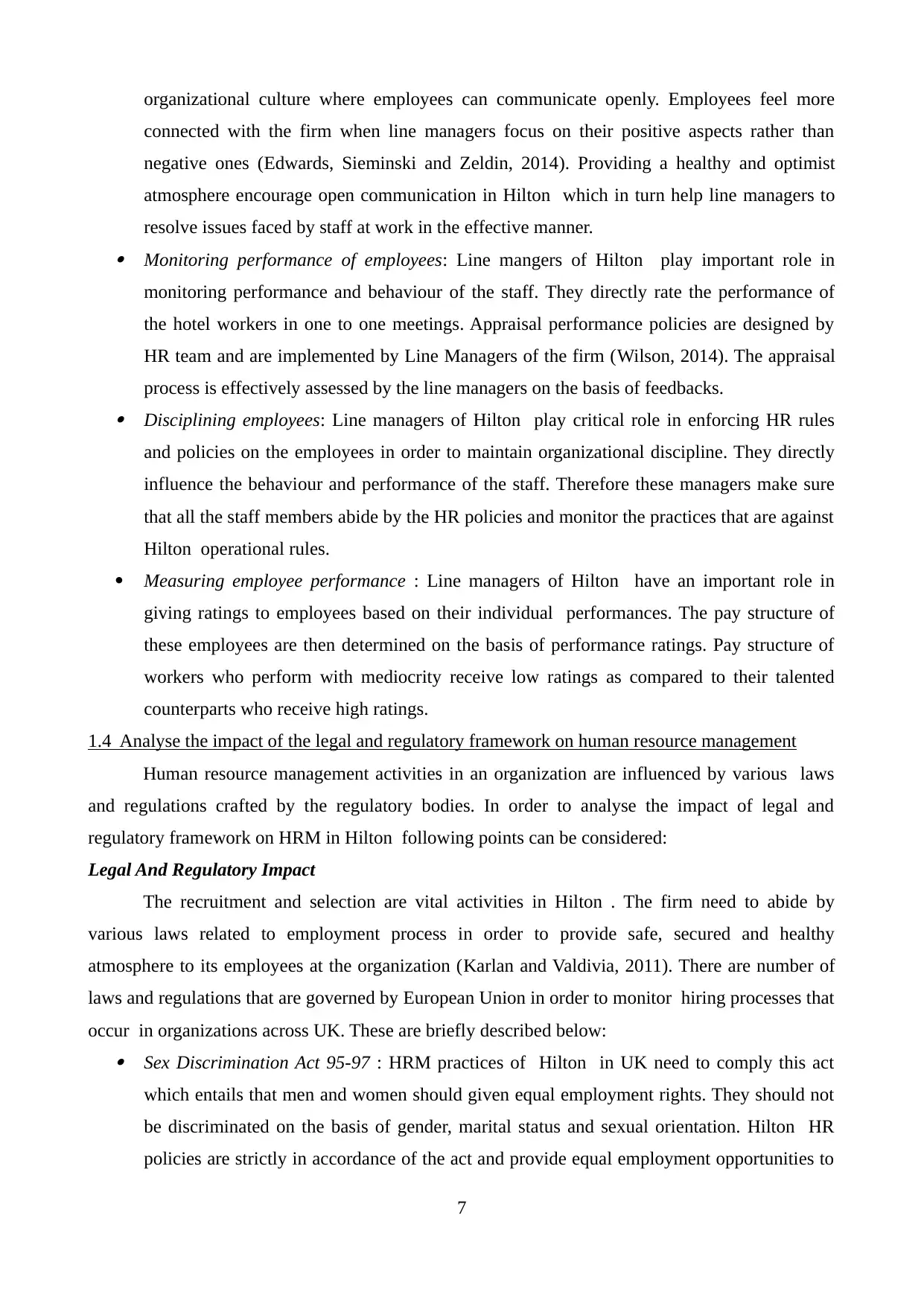
organizational culture where employees can communicate openly. Employees feel more
connected with the firm when line managers focus on their positive aspects rather than
negative ones (Edwards, Sieminski and Zeldin, 2014). Providing a healthy and optimist
atmosphere encourage open communication in Hilton which in turn help line managers to
resolve issues faced by staff at work in the effective manner. Monitoring performance of employees: Line mangers of Hilton play important role in
monitoring performance and behaviour of the staff. They directly rate the performance of
the hotel workers in one to one meetings. Appraisal performance policies are designed by
HR team and are implemented by Line Managers of the firm (Wilson, 2014). The appraisal
process is effectively assessed by the line managers on the basis of feedbacks. Disciplining employees: Line managers of Hilton play critical role in enforcing HR rules
and policies on the employees in order to maintain organizational discipline. They directly
influence the behaviour and performance of the staff. Therefore these managers make sure
that all the staff members abide by the HR policies and monitor the practices that are against
Hilton operational rules.
Measuring employee performance : Line managers of Hilton have an important role in
giving ratings to employees based on their individual performances. The pay structure of
these employees are then determined on the basis of performance ratings. Pay structure of
workers who perform with mediocrity receive low ratings as compared to their talented
counterparts who receive high ratings.
1.4 Analyse the impact of the legal and regulatory framework on human resource management
Human resource management activities in an organization are influenced by various laws
and regulations crafted by the regulatory bodies. In order to analyse the impact of legal and
regulatory framework on HRM in Hilton following points can be considered:
Legal And Regulatory Impact
The recruitment and selection are vital activities in Hilton . The firm need to abide by
various laws related to employment process in order to provide safe, secured and healthy
atmosphere to its employees at the organization (Karlan and Valdivia, 2011). There are number of
laws and regulations that are governed by European Union in order to monitor hiring processes that
occur in organizations across UK. These are briefly described below: Sex Discrimination Act 95-97 : HRM practices of Hilton in UK need to comply this act
which entails that men and women should given equal employment rights. They should not
be discriminated on the basis of gender, marital status and sexual orientation. Hilton HR
policies are strictly in accordance of the act and provide equal employment opportunities to
7
connected with the firm when line managers focus on their positive aspects rather than
negative ones (Edwards, Sieminski and Zeldin, 2014). Providing a healthy and optimist
atmosphere encourage open communication in Hilton which in turn help line managers to
resolve issues faced by staff at work in the effective manner. Monitoring performance of employees: Line mangers of Hilton play important role in
monitoring performance and behaviour of the staff. They directly rate the performance of
the hotel workers in one to one meetings. Appraisal performance policies are designed by
HR team and are implemented by Line Managers of the firm (Wilson, 2014). The appraisal
process is effectively assessed by the line managers on the basis of feedbacks. Disciplining employees: Line managers of Hilton play critical role in enforcing HR rules
and policies on the employees in order to maintain organizational discipline. They directly
influence the behaviour and performance of the staff. Therefore these managers make sure
that all the staff members abide by the HR policies and monitor the practices that are against
Hilton operational rules.
Measuring employee performance : Line managers of Hilton have an important role in
giving ratings to employees based on their individual performances. The pay structure of
these employees are then determined on the basis of performance ratings. Pay structure of
workers who perform with mediocrity receive low ratings as compared to their talented
counterparts who receive high ratings.
1.4 Analyse the impact of the legal and regulatory framework on human resource management
Human resource management activities in an organization are influenced by various laws
and regulations crafted by the regulatory bodies. In order to analyse the impact of legal and
regulatory framework on HRM in Hilton following points can be considered:
Legal And Regulatory Impact
The recruitment and selection are vital activities in Hilton . The firm need to abide by
various laws related to employment process in order to provide safe, secured and healthy
atmosphere to its employees at the organization (Karlan and Valdivia, 2011). There are number of
laws and regulations that are governed by European Union in order to monitor hiring processes that
occur in organizations across UK. These are briefly described below: Sex Discrimination Act 95-97 : HRM practices of Hilton in UK need to comply this act
which entails that men and women should given equal employment rights. They should not
be discriminated on the basis of gender, marital status and sexual orientation. Hilton HR
policies are strictly in accordance of the act and provide equal employment opportunities to
7
Paraphrase This Document
Need a fresh take? Get an instant paraphrase of this document with our AI Paraphraser
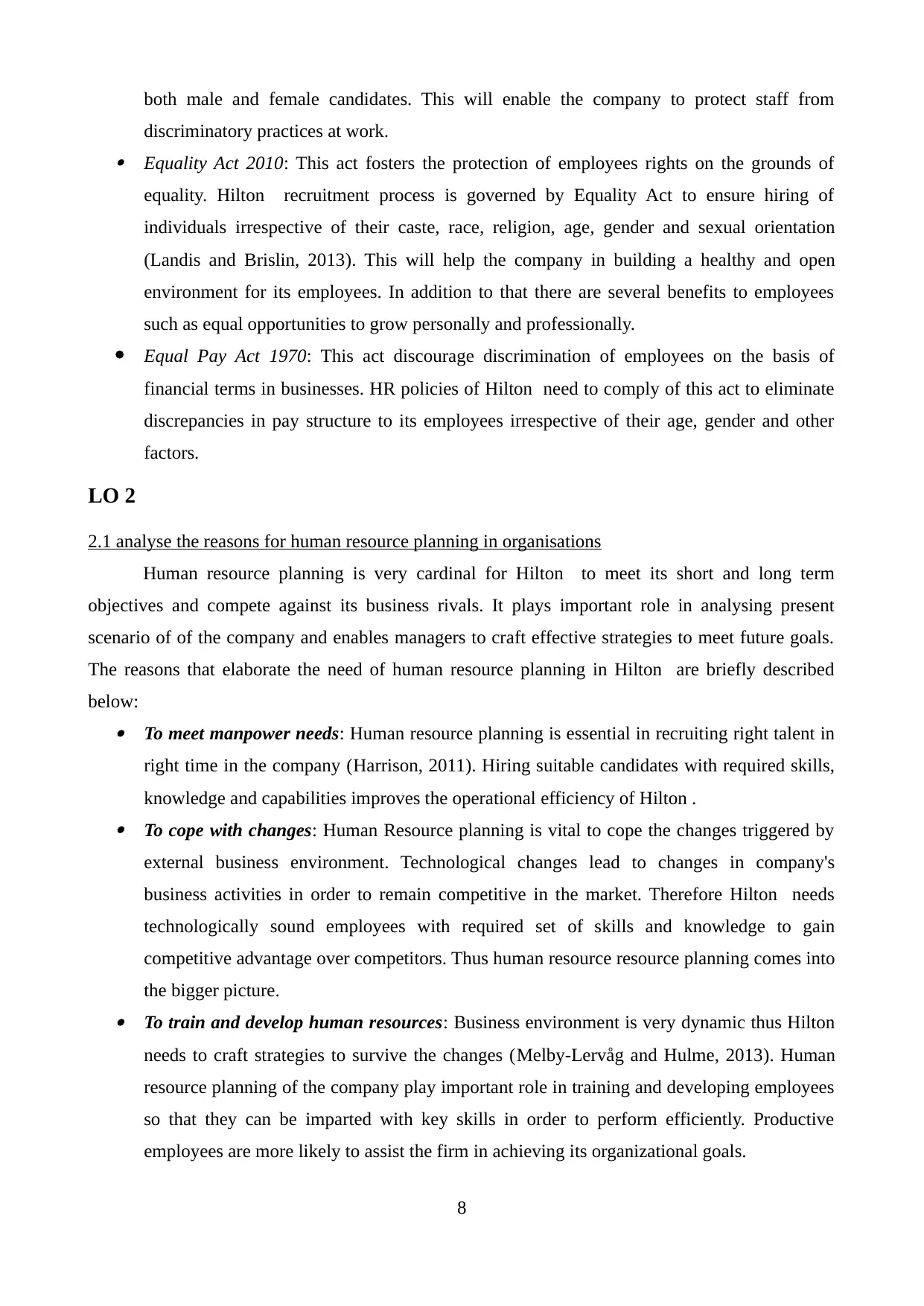
both male and female candidates. This will enable the company to protect staff from
discriminatory practices at work. Equality Act 2010: This act fosters the protection of employees rights on the grounds of
equality. Hilton recruitment process is governed by Equality Act to ensure hiring of
individuals irrespective of their caste, race, religion, age, gender and sexual orientation
(Landis and Brislin, 2013). This will help the company in building a healthy and open
environment for its employees. In addition to that there are several benefits to employees
such as equal opportunities to grow personally and professionally.
Equal Pay Act 1970: This act discourage discrimination of employees on the basis of
financial terms in businesses. HR policies of Hilton need to comply of this act to eliminate
discrepancies in pay structure to its employees irrespective of their age, gender and other
factors.
LO 2
2.1 analyse the reasons for human resource planning in organisations
Human resource planning is very cardinal for Hilton to meet its short and long term
objectives and compete against its business rivals. It plays important role in analysing present
scenario of of the company and enables managers to craft effective strategies to meet future goals.
The reasons that elaborate the need of human resource planning in Hilton are briefly described
below: To meet manpower needs: Human resource planning is essential in recruiting right talent in
right time in the company (Harrison, 2011). Hiring suitable candidates with required skills,
knowledge and capabilities improves the operational efficiency of Hilton . To cope with changes: Human Resource planning is vital to cope the changes triggered by
external business environment. Technological changes lead to changes in company's
business activities in order to remain competitive in the market. Therefore Hilton needs
technologically sound employees with required set of skills and knowledge to gain
competitive advantage over competitors. Thus human resource resource planning comes into
the bigger picture. To train and develop human resources: Business environment is very dynamic thus Hilton
needs to craft strategies to survive the changes (Melby-Lervåg and Hulme, 2013). Human
resource planning of the company play important role in training and developing employees
so that they can be imparted with key skills in order to perform efficiently. Productive
employees are more likely to assist the firm in achieving its organizational goals.
8
discriminatory practices at work. Equality Act 2010: This act fosters the protection of employees rights on the grounds of
equality. Hilton recruitment process is governed by Equality Act to ensure hiring of
individuals irrespective of their caste, race, religion, age, gender and sexual orientation
(Landis and Brislin, 2013). This will help the company in building a healthy and open
environment for its employees. In addition to that there are several benefits to employees
such as equal opportunities to grow personally and professionally.
Equal Pay Act 1970: This act discourage discrimination of employees on the basis of
financial terms in businesses. HR policies of Hilton need to comply of this act to eliminate
discrepancies in pay structure to its employees irrespective of their age, gender and other
factors.
LO 2
2.1 analyse the reasons for human resource planning in organisations
Human resource planning is very cardinal for Hilton to meet its short and long term
objectives and compete against its business rivals. It plays important role in analysing present
scenario of of the company and enables managers to craft effective strategies to meet future goals.
The reasons that elaborate the need of human resource planning in Hilton are briefly described
below: To meet manpower needs: Human resource planning is essential in recruiting right talent in
right time in the company (Harrison, 2011). Hiring suitable candidates with required skills,
knowledge and capabilities improves the operational efficiency of Hilton . To cope with changes: Human Resource planning is vital to cope the changes triggered by
external business environment. Technological changes lead to changes in company's
business activities in order to remain competitive in the market. Therefore Hilton needs
technologically sound employees with required set of skills and knowledge to gain
competitive advantage over competitors. Thus human resource resource planning comes into
the bigger picture. To train and develop human resources: Business environment is very dynamic thus Hilton
needs to craft strategies to survive the changes (Melby-Lervåg and Hulme, 2013). Human
resource planning of the company play important role in training and developing employees
so that they can be imparted with key skills in order to perform efficiently. Productive
employees are more likely to assist the firm in achieving its organizational goals.
8
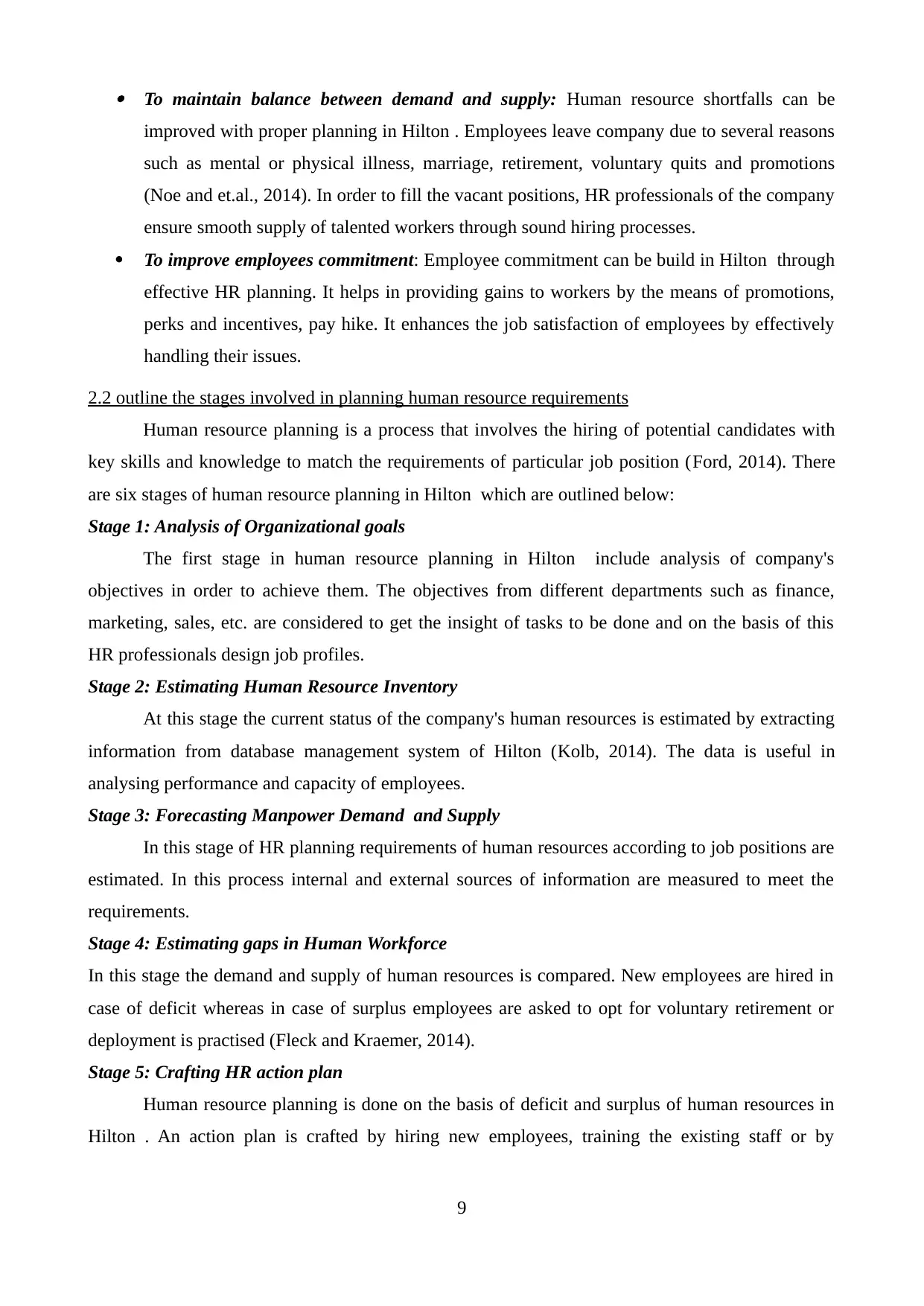
To maintain balance between demand and supply: Human resource shortfalls can be
improved with proper planning in Hilton . Employees leave company due to several reasons
such as mental or physical illness, marriage, retirement, voluntary quits and promotions
(Noe and et.al., 2014). In order to fill the vacant positions, HR professionals of the company
ensure smooth supply of talented workers through sound hiring processes.
To improve employees commitment: Employee commitment can be build in Hilton through
effective HR planning. It helps in providing gains to workers by the means of promotions,
perks and incentives, pay hike. It enhances the job satisfaction of employees by effectively
handling their issues.
2.2 outline the stages involved in planning human resource requirements
Human resource planning is a process that involves the hiring of potential candidates with
key skills and knowledge to match the requirements of particular job position (Ford, 2014). There
are six stages of human resource planning in Hilton which are outlined below:
Stage 1: Analysis of Organizational goals
The first stage in human resource planning in Hilton include analysis of company's
objectives in order to achieve them. The objectives from different departments such as finance,
marketing, sales, etc. are considered to get the insight of tasks to be done and on the basis of this
HR professionals design job profiles.
Stage 2: Estimating Human Resource Inventory
At this stage the current status of the company's human resources is estimated by extracting
information from database management system of Hilton (Kolb, 2014). The data is useful in
analysing performance and capacity of employees.
Stage 3: Forecasting Manpower Demand and Supply
In this stage of HR planning requirements of human resources according to job positions are
estimated. In this process internal and external sources of information are measured to meet the
requirements.
Stage 4: Estimating gaps in Human Workforce
In this stage the demand and supply of human resources is compared. New employees are hired in
case of deficit whereas in case of surplus employees are asked to opt for voluntary retirement or
deployment is practised (Fleck and Kraemer, 2014).
Stage 5: Crafting HR action plan
Human resource planning is done on the basis of deficit and surplus of human resources in
Hilton . An action plan is crafted by hiring new employees, training the existing staff or by
9
improved with proper planning in Hilton . Employees leave company due to several reasons
such as mental or physical illness, marriage, retirement, voluntary quits and promotions
(Noe and et.al., 2014). In order to fill the vacant positions, HR professionals of the company
ensure smooth supply of talented workers through sound hiring processes.
To improve employees commitment: Employee commitment can be build in Hilton through
effective HR planning. It helps in providing gains to workers by the means of promotions,
perks and incentives, pay hike. It enhances the job satisfaction of employees by effectively
handling their issues.
2.2 outline the stages involved in planning human resource requirements
Human resource planning is a process that involves the hiring of potential candidates with
key skills and knowledge to match the requirements of particular job position (Ford, 2014). There
are six stages of human resource planning in Hilton which are outlined below:
Stage 1: Analysis of Organizational goals
The first stage in human resource planning in Hilton include analysis of company's
objectives in order to achieve them. The objectives from different departments such as finance,
marketing, sales, etc. are considered to get the insight of tasks to be done and on the basis of this
HR professionals design job profiles.
Stage 2: Estimating Human Resource Inventory
At this stage the current status of the company's human resources is estimated by extracting
information from database management system of Hilton (Kolb, 2014). The data is useful in
analysing performance and capacity of employees.
Stage 3: Forecasting Manpower Demand and Supply
In this stage of HR planning requirements of human resources according to job positions are
estimated. In this process internal and external sources of information are measured to meet the
requirements.
Stage 4: Estimating gaps in Human Workforce
In this stage the demand and supply of human resources is compared. New employees are hired in
case of deficit whereas in case of surplus employees are asked to opt for voluntary retirement or
deployment is practised (Fleck and Kraemer, 2014).
Stage 5: Crafting HR action plan
Human resource planning is done on the basis of deficit and surplus of human resources in
Hilton . An action plan is crafted by hiring new employees, training the existing staff or by
9

facilitating interdepartmental transfers in case of employee deficit (Jabbour and Santos, 2008). On
the contrary, HR team plans to terminate or deploy workers in case of surplus human resources in
the firm.
Stage 6: Monitoring, Control and feedback
The stage involves the implementation of human resource plan in Hilton . The plan is
monitored to identify flaws and measures are taken to fix them. Hence planning and implementation
is compared to achieve goals of the firm in the most effective manner.
2.3 compare the recruitment and selection process in two organisations
The recruitment and selection process differ from company to company. To study the
comparison of recruitment process in two organizations, Hilton and McDonald are chosen. The key
points included in comparison are as follows:
Hilton's HRM department identifies the vacancy in different departments and accordingly
plan recruitment process. Hilton's HR professionals post job vacancies on suitable portals such as
company's website and popular job websites in order to invite applications from suitable applicants
(Johnston, Bringall and Fitzgerald, 2002). After receiving the application from candidates the HR
team consult departmental heads to review the skills and experience of the right candidates for
further screening. The shortlisted candidates are then called for telephonic interviews for first phase
of screening. The next phase of the selection process include personality test, personal interviews,
group discussions, role plays, work related scenarios in order to evaluate technical skills and
behavioural aspects of applicants. The selected candidates with required skills go through the pre
employment check by Hilton's HR team. The documents of applicants such educational certificates
and personal identification papers are verified by the team. Successful candidates are given
employment letter and induction session is conducted in the final phase of the process.
On the contrary Mc Donald's recruits new employees by two sources. These include internal
sources such as employee referrals and external sources by advertising the positions in newspapers
and job portals. The initial screening is done by the HR managers and candidates with desired skills
are shortlisted. The shortlisted candidates are then interviewed at the final stage and recruited in the
company (Marchington and Wilkinson, 2008). Mc Donalds invite applications form young people
who have pleasant personality and good communication skills.
2.4 evaluate the effectiveness of the recruitment and selection techniques in two organisations 290
In order to evaluate the effectiveness of the recruitment and selection techniques in Hilton and Mc
Donald's following points can be considered:
The recruitment and selection process in Hilton is very extensive. The job vacancy is
10
the contrary, HR team plans to terminate or deploy workers in case of surplus human resources in
the firm.
Stage 6: Monitoring, Control and feedback
The stage involves the implementation of human resource plan in Hilton . The plan is
monitored to identify flaws and measures are taken to fix them. Hence planning and implementation
is compared to achieve goals of the firm in the most effective manner.
2.3 compare the recruitment and selection process in two organisations
The recruitment and selection process differ from company to company. To study the
comparison of recruitment process in two organizations, Hilton and McDonald are chosen. The key
points included in comparison are as follows:
Hilton's HRM department identifies the vacancy in different departments and accordingly
plan recruitment process. Hilton's HR professionals post job vacancies on suitable portals such as
company's website and popular job websites in order to invite applications from suitable applicants
(Johnston, Bringall and Fitzgerald, 2002). After receiving the application from candidates the HR
team consult departmental heads to review the skills and experience of the right candidates for
further screening. The shortlisted candidates are then called for telephonic interviews for first phase
of screening. The next phase of the selection process include personality test, personal interviews,
group discussions, role plays, work related scenarios in order to evaluate technical skills and
behavioural aspects of applicants. The selected candidates with required skills go through the pre
employment check by Hilton's HR team. The documents of applicants such educational certificates
and personal identification papers are verified by the team. Successful candidates are given
employment letter and induction session is conducted in the final phase of the process.
On the contrary Mc Donald's recruits new employees by two sources. These include internal
sources such as employee referrals and external sources by advertising the positions in newspapers
and job portals. The initial screening is done by the HR managers and candidates with desired skills
are shortlisted. The shortlisted candidates are then interviewed at the final stage and recruited in the
company (Marchington and Wilkinson, 2008). Mc Donalds invite applications form young people
who have pleasant personality and good communication skills.
2.4 evaluate the effectiveness of the recruitment and selection techniques in two organisations 290
In order to evaluate the effectiveness of the recruitment and selection techniques in Hilton and Mc
Donald's following points can be considered:
The recruitment and selection process in Hilton is very extensive. The job vacancy is
10
Secure Best Marks with AI Grader
Need help grading? Try our AI Grader for instant feedback on your assignments.

identified and job profile is designed to elaborate the key skills required for performing the job.
The job vacancy is posted in company's website and popular job portals in order to streamline the
search process. The applications are invited and screened before initiating the next phase of the
selection process (Laroche and Rutherford, 2007). The shortlisted candidates with required skills
are then called for interviews. The personal behaviour and technical skills are checked through
personality tests, group discussions, aptitude tests, role plays and work related scenarios. The HR
team verified the documents in order to check for authenticity of applicants such as personal
identification certificates and educational qualifications. The selected applicants are then
interviewed by the panel in the final stage. Once the recruiters find the applicant with the set of
right skills and knowledge is employed in the organization.
On the other hand the recruitment and selection process of Mc Donalds is initiated when the
position is need to be replaced. The job vacancies are then communicated to HR department in
order to post the vacancy. Mc Donalds posts its job positions by using two sources that are internal
sources such as employee referrals and external sources such as newspapers and online job portals.
The candidates with desired skills are selected for interview and given employment letter after final
screening.
LO 3
3.1 Assessing the link between motivational theory and reward
Motivation can be defined as a set of forces that determine the behaviour and actions of an
individual in a specific way. There is a strong link between rewards and motivation in
organizational behaviour. The link between motivational theories and reward in Hilton Hotels can
be described in the following points:
11
The job vacancy is posted in company's website and popular job portals in order to streamline the
search process. The applications are invited and screened before initiating the next phase of the
selection process (Laroche and Rutherford, 2007). The shortlisted candidates with required skills
are then called for interviews. The personal behaviour and technical skills are checked through
personality tests, group discussions, aptitude tests, role plays and work related scenarios. The HR
team verified the documents in order to check for authenticity of applicants such as personal
identification certificates and educational qualifications. The selected applicants are then
interviewed by the panel in the final stage. Once the recruiters find the applicant with the set of
right skills and knowledge is employed in the organization.
On the other hand the recruitment and selection process of Mc Donalds is initiated when the
position is need to be replaced. The job vacancies are then communicated to HR department in
order to post the vacancy. Mc Donalds posts its job positions by using two sources that are internal
sources such as employee referrals and external sources such as newspapers and online job portals.
The candidates with desired skills are selected for interview and given employment letter after final
screening.
LO 3
3.1 Assessing the link between motivational theory and reward
Motivation can be defined as a set of forces that determine the behaviour and actions of an
individual in a specific way. There is a strong link between rewards and motivation in
organizational behaviour. The link between motivational theories and reward in Hilton Hotels can
be described in the following points:
11
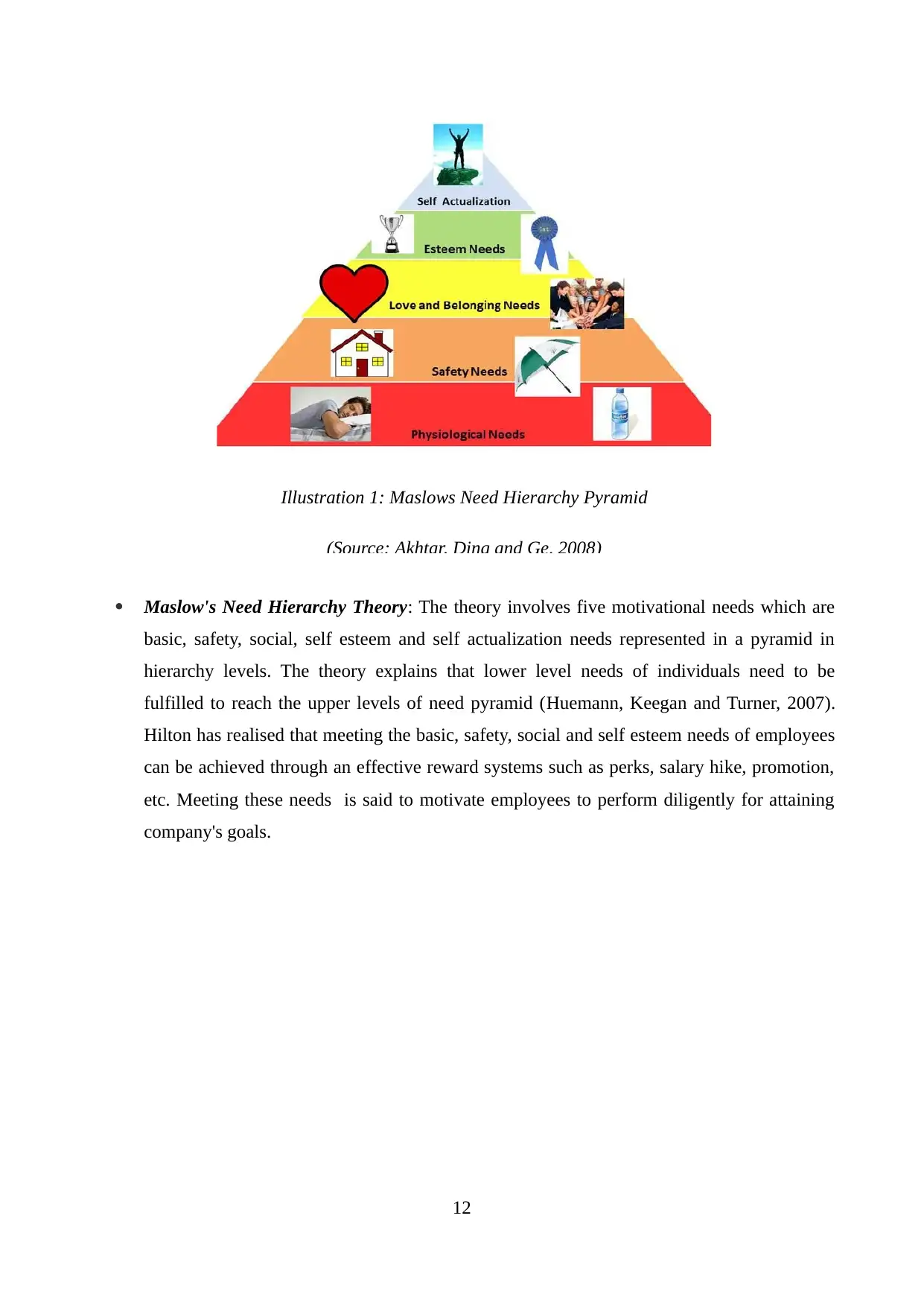
Maslow's Need Hierarchy Theory: The theory involves five motivational needs which are
basic, safety, social, self esteem and self actualization needs represented in a pyramid in
hierarchy levels. The theory explains that lower level needs of individuals need to be
fulfilled to reach the upper levels of need pyramid (Huemann, Keegan and Turner, 2007).
Hilton has realised that meeting the basic, safety, social and self esteem needs of employees
can be achieved through an effective reward systems such as perks, salary hike, promotion,
etc. Meeting these needs is said to motivate employees to perform diligently for attaining
company's goals.
12
Illustration 1: Maslows Need Hierarchy Pyramid
(Source: Akhtar, Ding and Ge, 2008)
basic, safety, social, self esteem and self actualization needs represented in a pyramid in
hierarchy levels. The theory explains that lower level needs of individuals need to be
fulfilled to reach the upper levels of need pyramid (Huemann, Keegan and Turner, 2007).
Hilton has realised that meeting the basic, safety, social and self esteem needs of employees
can be achieved through an effective reward systems such as perks, salary hike, promotion,
etc. Meeting these needs is said to motivate employees to perform diligently for attaining
company's goals.
12
Illustration 1: Maslows Need Hierarchy Pyramid
(Source: Akhtar, Ding and Ge, 2008)
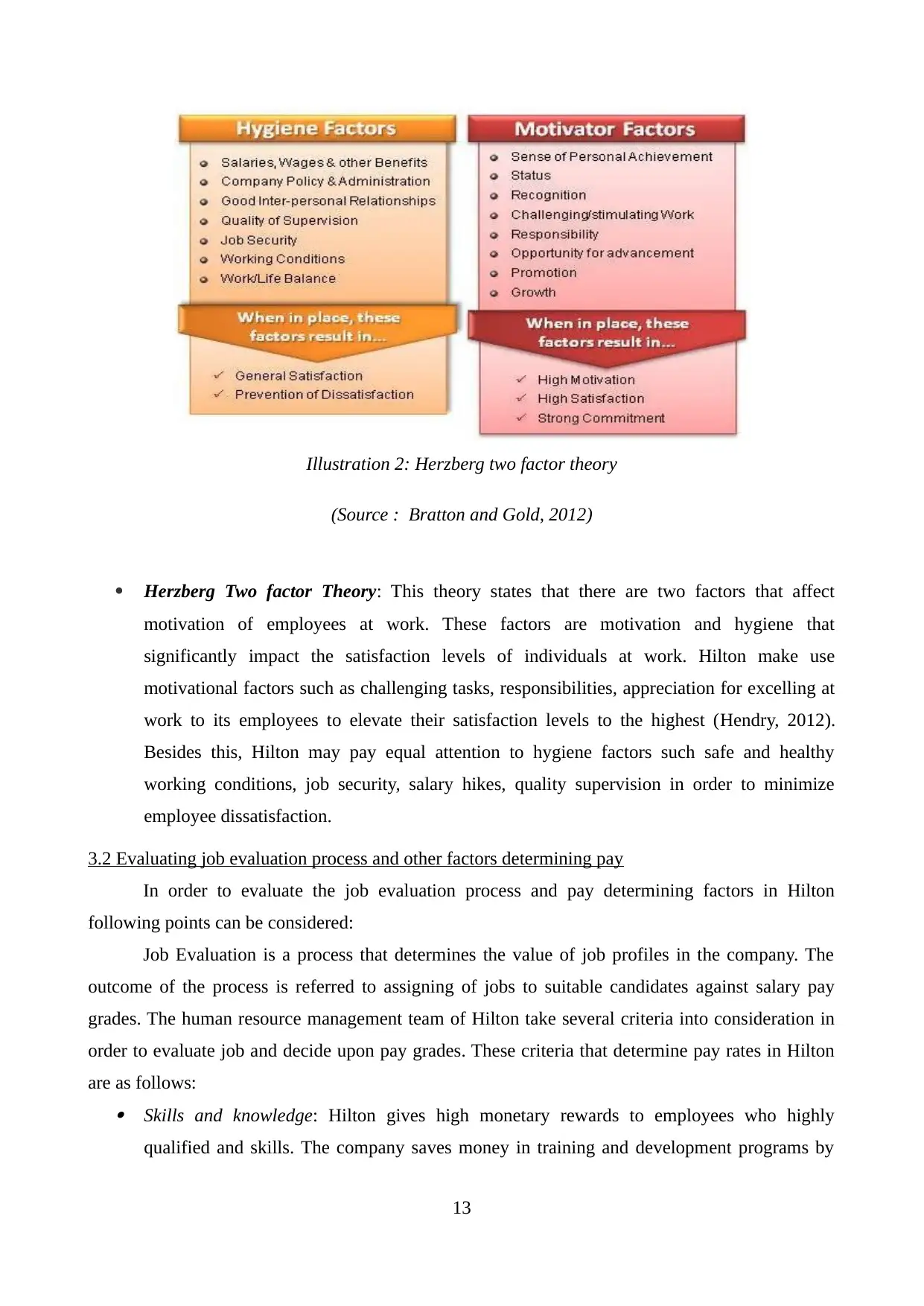
Herzberg Two factor Theory: This theory states that there are two factors that affect
motivation of employees at work. These factors are motivation and hygiene that
significantly impact the satisfaction levels of individuals at work. Hilton make use
motivational factors such as challenging tasks, responsibilities, appreciation for excelling at
work to its employees to elevate their satisfaction levels to the highest (Hendry, 2012).
Besides this, Hilton may pay equal attention to hygiene factors such safe and healthy
working conditions, job security, salary hikes, quality supervision in order to minimize
employee dissatisfaction.
3.2 Evaluating job evaluation process and other factors determining pay
In order to evaluate the job evaluation process and pay determining factors in Hilton
following points can be considered:
Job Evaluation is a process that determines the value of job profiles in the company. The
outcome of the process is referred to assigning of jobs to suitable candidates against salary pay
grades. The human resource management team of Hilton take several criteria into consideration in
order to evaluate job and decide upon pay grades. These criteria that determine pay rates in Hilton
are as follows: Skills and knowledge: Hilton gives high monetary rewards to employees who highly
qualified and skills. The company saves money in training and development programs by
13
Illustration 2: Herzberg two factor theory
(Source : Bratton and Gold, 2012)
motivation of employees at work. These factors are motivation and hygiene that
significantly impact the satisfaction levels of individuals at work. Hilton make use
motivational factors such as challenging tasks, responsibilities, appreciation for excelling at
work to its employees to elevate their satisfaction levels to the highest (Hendry, 2012).
Besides this, Hilton may pay equal attention to hygiene factors such safe and healthy
working conditions, job security, salary hikes, quality supervision in order to minimize
employee dissatisfaction.
3.2 Evaluating job evaluation process and other factors determining pay
In order to evaluate the job evaluation process and pay determining factors in Hilton
following points can be considered:
Job Evaluation is a process that determines the value of job profiles in the company. The
outcome of the process is referred to assigning of jobs to suitable candidates against salary pay
grades. The human resource management team of Hilton take several criteria into consideration in
order to evaluate job and decide upon pay grades. These criteria that determine pay rates in Hilton
are as follows: Skills and knowledge: Hilton gives high monetary rewards to employees who highly
qualified and skills. The company saves money in training and development programs by
13
Illustration 2: Herzberg two factor theory
(Source : Bratton and Gold, 2012)
Paraphrase This Document
Need a fresh take? Get an instant paraphrase of this document with our AI Paraphraser

hiring highly skilled workers. Job or project complexity: Hilton considers this factor in order to evaluate the job done by
employees with respect to the degree of complexity in the project or task (Laroche and
Rutherford, 2007).. Leadership qualities: Hilton gives perks and incentives to employees who direct and
instructs other team members in achieving company's goals in the most effective manner.
Meeting deadlines: Workers who perform job within the given deadline is entitled to get
better reward in Hilton.
3.3 Assessing effectiveness of reward systems in different contexts
Hilton's reward systems are programs that are designed by the firm to motivate its
employees for showing extraordinary performance at work. In order to assess the effectiveness of
reward systems of Hilton in different contexts following points can be considered: Motivating employees during peak work load: The reward systems are effective in
motivating employees to work during peak work load seasons. Monetory reward act as great
tools to engage employees in achieving long and short term goals. Delivering high quality customer services: Reward systems prove useful to Hilton to
enhance customer satisfactions by engaging its employees who directly communicate with
the local and international customers. Hilton operates in highly competitive service industry,
thus it can gain competitive advantage over competitors by providing high class services to
its customs (Harrison, 2011).. This cannot be achieved if employees are not motivated to
service efficiently. Thus Hilton designs its reward systems for its staff to build strong
employee commitment. Completing a complex task within a stipulated task: Rewards systems are beneficial in
creating a sense of achievement among employees (Laroche and Rutherford, 2007)..
Monitory and recognition reward systems such as bonuses, profit sharing and promotion can
be implemented to elevate satisfaction levels of workers to improve their productivity.
Rewarding an employee or a team motivate other team members in the organization to
perform extraordinarily at work.
Improving operational efficiency: Motivating employees through sound reward systems not
only increase the satisfaction levels of employees but also improves operational
effectiveness of Hilton. Motivated employees feel the urge of showing commitment at work
and thus are dedicated towards their job duties.
14
employees with respect to the degree of complexity in the project or task (Laroche and
Rutherford, 2007).. Leadership qualities: Hilton gives perks and incentives to employees who direct and
instructs other team members in achieving company's goals in the most effective manner.
Meeting deadlines: Workers who perform job within the given deadline is entitled to get
better reward in Hilton.
3.3 Assessing effectiveness of reward systems in different contexts
Hilton's reward systems are programs that are designed by the firm to motivate its
employees for showing extraordinary performance at work. In order to assess the effectiveness of
reward systems of Hilton in different contexts following points can be considered: Motivating employees during peak work load: The reward systems are effective in
motivating employees to work during peak work load seasons. Monetory reward act as great
tools to engage employees in achieving long and short term goals. Delivering high quality customer services: Reward systems prove useful to Hilton to
enhance customer satisfactions by engaging its employees who directly communicate with
the local and international customers. Hilton operates in highly competitive service industry,
thus it can gain competitive advantage over competitors by providing high class services to
its customs (Harrison, 2011).. This cannot be achieved if employees are not motivated to
service efficiently. Thus Hilton designs its reward systems for its staff to build strong
employee commitment. Completing a complex task within a stipulated task: Rewards systems are beneficial in
creating a sense of achievement among employees (Laroche and Rutherford, 2007)..
Monitory and recognition reward systems such as bonuses, profit sharing and promotion can
be implemented to elevate satisfaction levels of workers to improve their productivity.
Rewarding an employee or a team motivate other team members in the organization to
perform extraordinarily at work.
Improving operational efficiency: Motivating employees through sound reward systems not
only increase the satisfaction levels of employees but also improves operational
effectiveness of Hilton. Motivated employees feel the urge of showing commitment at work
and thus are dedicated towards their job duties.
14
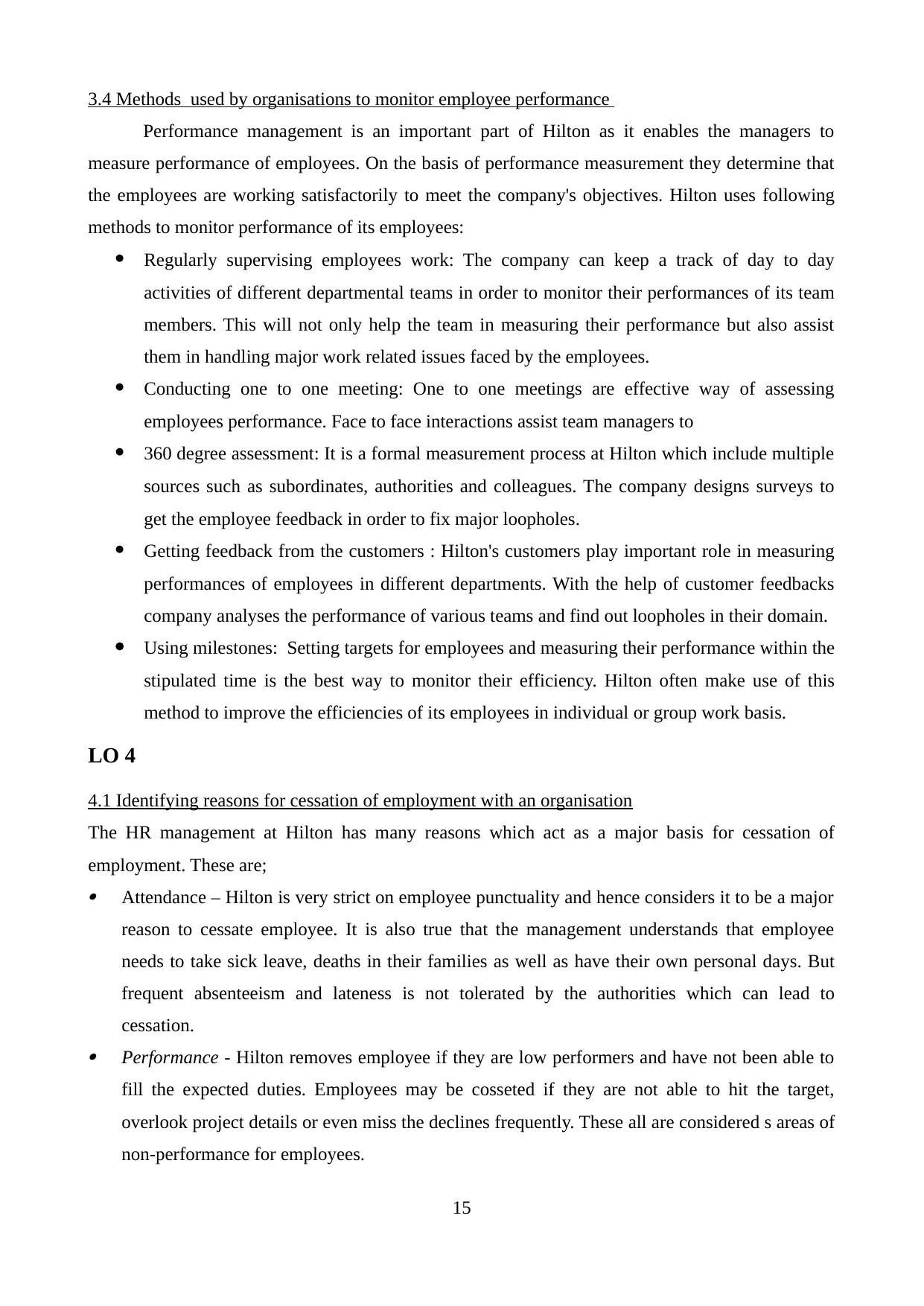
3.4 Methods used by organisations to monitor employee performance
Performance management is an important part of Hilton as it enables the managers to
measure performance of employees. On the basis of performance measurement they determine that
the employees are working satisfactorily to meet the company's objectives. Hilton uses following
methods to monitor performance of its employees:
Regularly supervising employees work: The company can keep a track of day to day
activities of different departmental teams in order to monitor their performances of its team
members. This will not only help the team in measuring their performance but also assist
them in handling major work related issues faced by the employees.
Conducting one to one meeting: One to one meetings are effective way of assessing
employees performance. Face to face interactions assist team managers to
360 degree assessment: It is a formal measurement process at Hilton which include multiple
sources such as subordinates, authorities and colleagues. The company designs surveys to
get the employee feedback in order to fix major loopholes.
Getting feedback from the customers : Hilton's customers play important role in measuring
performances of employees in different departments. With the help of customer feedbacks
company analyses the performance of various teams and find out loopholes in their domain.
Using milestones: Setting targets for employees and measuring their performance within the
stipulated time is the best way to monitor their efficiency. Hilton often make use of this
method to improve the efficiencies of its employees in individual or group work basis.
LO 4
4.1 Identifying reasons for cessation of employment with an organisation
The HR management at Hilton has many reasons which act as a major basis for cessation of
employment. These are; Attendance – Hilton is very strict on employee punctuality and hence considers it to be a major
reason to cessate employee. It is also true that the management understands that employee
needs to take sick leave, deaths in their families as well as have their own personal days. But
frequent absenteeism and lateness is not tolerated by the authorities which can lead to
cessation. Performance - Hilton removes employee if they are low performers and have not been able to
fill the expected duties. Employees may be cosseted if they are not able to hit the target,
overlook project details or even miss the declines frequently. These all are considered s areas of
non-performance for employees.
15
Performance management is an important part of Hilton as it enables the managers to
measure performance of employees. On the basis of performance measurement they determine that
the employees are working satisfactorily to meet the company's objectives. Hilton uses following
methods to monitor performance of its employees:
Regularly supervising employees work: The company can keep a track of day to day
activities of different departmental teams in order to monitor their performances of its team
members. This will not only help the team in measuring their performance but also assist
them in handling major work related issues faced by the employees.
Conducting one to one meeting: One to one meetings are effective way of assessing
employees performance. Face to face interactions assist team managers to
360 degree assessment: It is a formal measurement process at Hilton which include multiple
sources such as subordinates, authorities and colleagues. The company designs surveys to
get the employee feedback in order to fix major loopholes.
Getting feedback from the customers : Hilton's customers play important role in measuring
performances of employees in different departments. With the help of customer feedbacks
company analyses the performance of various teams and find out loopholes in their domain.
Using milestones: Setting targets for employees and measuring their performance within the
stipulated time is the best way to monitor their efficiency. Hilton often make use of this
method to improve the efficiencies of its employees in individual or group work basis.
LO 4
4.1 Identifying reasons for cessation of employment with an organisation
The HR management at Hilton has many reasons which act as a major basis for cessation of
employment. These are; Attendance – Hilton is very strict on employee punctuality and hence considers it to be a major
reason to cessate employee. It is also true that the management understands that employee
needs to take sick leave, deaths in their families as well as have their own personal days. But
frequent absenteeism and lateness is not tolerated by the authorities which can lead to
cessation. Performance - Hilton removes employee if they are low performers and have not been able to
fill the expected duties. Employees may be cosseted if they are not able to hit the target,
overlook project details or even miss the declines frequently. These all are considered s areas of
non-performance for employees.
15
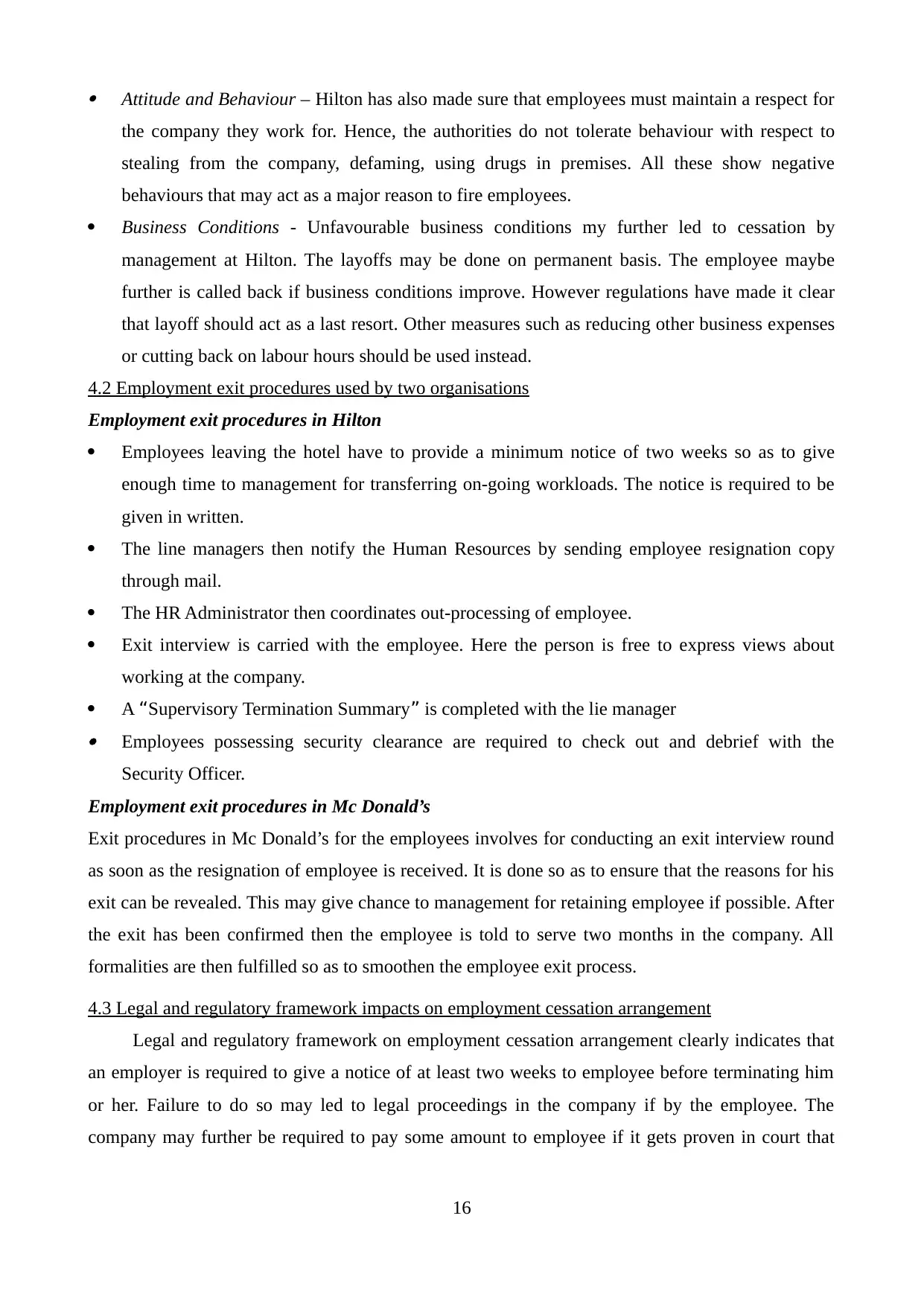
Attitude and Behaviour – Hilton has also made sure that employees must maintain a respect for
the company they work for. Hence, the authorities do not tolerate behaviour with respect to
stealing from the company, defaming, using drugs in premises. All these show negative
behaviours that may act as a major reason to fire employees.
Business Conditions - Unfavourable business conditions my further led to cessation by
management at Hilton. The layoffs may be done on permanent basis. The employee maybe
further is called back if business conditions improve. However regulations have made it clear
that layoff should act as a last resort. Other measures such as reducing other business expenses
or cutting back on labour hours should be used instead.
4.2 Employment exit procedures used by two organisations
Employment exit procedures in Hilton
Employees leaving the hotel have to provide a minimum notice of two weeks so as to give
enough time to management for transferring on-going workloads. The notice is required to be
given in written.
The line managers then notify the Human Resources by sending employee resignation copy
through mail.
The HR Administrator then coordinates out-processing of employee.
Exit interview is carried with the employee. Here the person is free to express views about
working at the company.
A “Supervisory Termination Summary” is completed with the lie manager Employees possessing security clearance are required to check out and debrief with the
Security Officer.
Employment exit procedures in Mc Donald’s
Exit procedures in Mc Donald’s for the employees involves for conducting an exit interview round
as soon as the resignation of employee is received. It is done so as to ensure that the reasons for his
exit can be revealed. This may give chance to management for retaining employee if possible. After
the exit has been confirmed then the employee is told to serve two months in the company. All
formalities are then fulfilled so as to smoothen the employee exit process.
4.3 Legal and regulatory framework impacts on employment cessation arrangement
Legal and regulatory framework on employment cessation arrangement clearly indicates that
an employer is required to give a notice of at least two weeks to employee before terminating him
or her. Failure to do so may led to legal proceedings in the company if by the employee. The
company may further be required to pay some amount to employee if it gets proven in court that
16
the company they work for. Hence, the authorities do not tolerate behaviour with respect to
stealing from the company, defaming, using drugs in premises. All these show negative
behaviours that may act as a major reason to fire employees.
Business Conditions - Unfavourable business conditions my further led to cessation by
management at Hilton. The layoffs may be done on permanent basis. The employee maybe
further is called back if business conditions improve. However regulations have made it clear
that layoff should act as a last resort. Other measures such as reducing other business expenses
or cutting back on labour hours should be used instead.
4.2 Employment exit procedures used by two organisations
Employment exit procedures in Hilton
Employees leaving the hotel have to provide a minimum notice of two weeks so as to give
enough time to management for transferring on-going workloads. The notice is required to be
given in written.
The line managers then notify the Human Resources by sending employee resignation copy
through mail.
The HR Administrator then coordinates out-processing of employee.
Exit interview is carried with the employee. Here the person is free to express views about
working at the company.
A “Supervisory Termination Summary” is completed with the lie manager Employees possessing security clearance are required to check out and debrief with the
Security Officer.
Employment exit procedures in Mc Donald’s
Exit procedures in Mc Donald’s for the employees involves for conducting an exit interview round
as soon as the resignation of employee is received. It is done so as to ensure that the reasons for his
exit can be revealed. This may give chance to management for retaining employee if possible. After
the exit has been confirmed then the employee is told to serve two months in the company. All
formalities are then fulfilled so as to smoothen the employee exit process.
4.3 Legal and regulatory framework impacts on employment cessation arrangement
Legal and regulatory framework on employment cessation arrangement clearly indicates that
an employer is required to give a notice of at least two weeks to employee before terminating him
or her. Failure to do so may led to legal proceedings in the company if by the employee. The
company may further be required to pay some amount to employee if it gets proven in court that
16
Secure Best Marks with AI Grader
Need help grading? Try our AI Grader for instant feedback on your assignments.

notice was not given to employee.
The framework further states that if an employer ends contract based on wrong behaviour of
employee then he should do so within four weeks of being aware about employee behaviour. After
that period employer does not have a right to terminate the employee without notice. Failure to do
so may further led to legal proceeding against many. It may also tarnish overall image of company
(Hendry, 2012). In the same way, if dismissal of employee has been taken on account of
redundancy, then employee has a right to written statement which clearly indicates how the
redundancy payment has been calculated. Similarly, employee has further got a right to give notice
in writing has been laid off without pay for more than 120 days.
CONCLUSION
In a nutshell, the Human Resource Management play important role in carrying out vital
activities such as planning, staffing, training and retaining talented employees that are essential
resources for organizations. There are various functions of HRM that are critical for companies to
achieve their desired objectives and gain competitive advantages over rival firms. Line Managers
implement strategies formulated by human resource team to monitor and motivate employees. It is
also studied in the report that there are several reasons that elaborate the significance of human
resource planning in the given company. These needs are fulfilled with effective HR action plan.
The plan is executed through six important stages. In addition to this there are several laws and
regulations that govern the employment processes in the organization. The report also gives a clear
understanding on the link between motivation theories and reward system These theories explain
that rewards can invoke the sense of motivation among employees. Apart from this, effectiveness of
reward system is analysed factors to evaluate job and determine the pay grades in the organization.
Last but not the least the report gives a clear picture of employment exit procedures in
organizations.
17
The framework further states that if an employer ends contract based on wrong behaviour of
employee then he should do so within four weeks of being aware about employee behaviour. After
that period employer does not have a right to terminate the employee without notice. Failure to do
so may further led to legal proceeding against many. It may also tarnish overall image of company
(Hendry, 2012). In the same way, if dismissal of employee has been taken on account of
redundancy, then employee has a right to written statement which clearly indicates how the
redundancy payment has been calculated. Similarly, employee has further got a right to give notice
in writing has been laid off without pay for more than 120 days.
CONCLUSION
In a nutshell, the Human Resource Management play important role in carrying out vital
activities such as planning, staffing, training and retaining talented employees that are essential
resources for organizations. There are various functions of HRM that are critical for companies to
achieve their desired objectives and gain competitive advantages over rival firms. Line Managers
implement strategies formulated by human resource team to monitor and motivate employees. It is
also studied in the report that there are several reasons that elaborate the significance of human
resource planning in the given company. These needs are fulfilled with effective HR action plan.
The plan is executed through six important stages. In addition to this there are several laws and
regulations that govern the employment processes in the organization. The report also gives a clear
understanding on the link between motivation theories and reward system These theories explain
that rewards can invoke the sense of motivation among employees. Apart from this, effectiveness of
reward system is analysed factors to evaluate job and determine the pay grades in the organization.
Last but not the least the report gives a clear picture of employment exit procedures in
organizations.
17
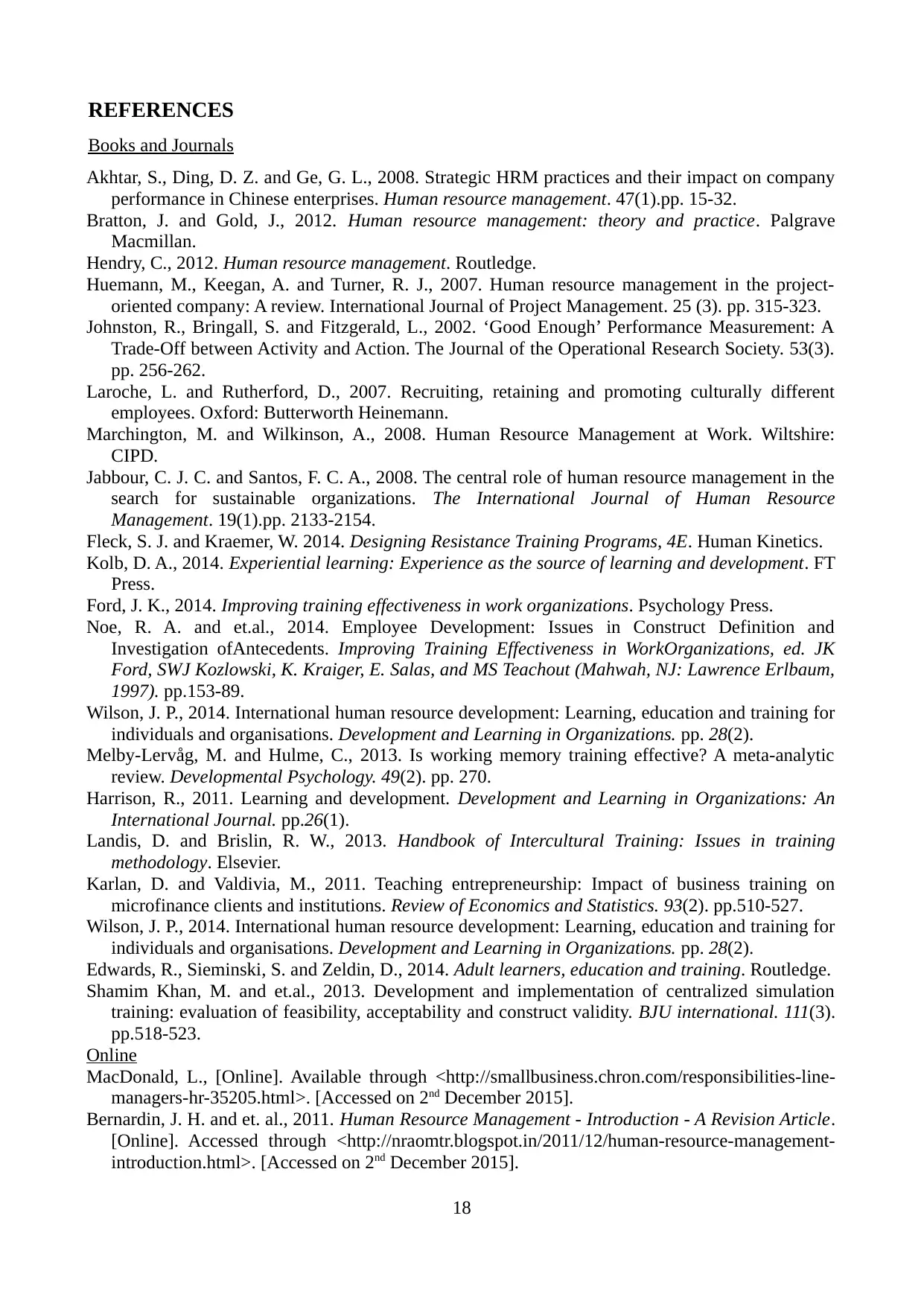
REFERENCES
Books and Journals
Akhtar, S., Ding, D. Z. and Ge, G. L., 2008. Strategic HRM practices and their impact on company
performance in Chinese enterprises. Human resource management. 47(1).pp. 15-32.
Bratton, J. and Gold, J., 2012. Human resource management: theory and practice. Palgrave
Macmillan.
Hendry, C., 2012. Human resource management. Routledge.
Huemann, M., Keegan, A. and Turner, R. J., 2007. Human resource management in the project-
oriented company: A review. International Journal of Project Management. 25 (3). pp. 315-323.
Johnston, R., Bringall, S. and Fitzgerald, L., 2002. ‘Good Enough’ Performance Measurement: A
Trade-Off between Activity and Action. The Journal of the Operational Research Society. 53(3).
pp. 256-262.
Laroche, L. and Rutherford, D., 2007. Recruiting, retaining and promoting culturally different
employees. Oxford: Butterworth Heinemann.
Marchington, M. and Wilkinson, A., 2008. Human Resource Management at Work. Wiltshire:
CIPD.
Jabbour, C. J. C. and Santos, F. C. A., 2008. The central role of human resource management in the
search for sustainable organizations. The International Journal of Human Resource
Management. 19(1).pp. 2133-2154.
Fleck, S. J. and Kraemer, W. 2014. Designing Resistance Training Programs, 4E. Human Kinetics.
Kolb, D. A., 2014. Experiential learning: Experience as the source of learning and development. FT
Press.
Ford, J. K., 2014. Improving training effectiveness in work organizations. Psychology Press.
Noe, R. A. and et.al., 2014. Employee Development: Issues in Construct Definition and
Investigation ofAntecedents. Improving Training Effectiveness in WorkOrganizations, ed. JK
Ford, SWJ Kozlowski, K. Kraiger, E. Salas, and MS Teachout (Mahwah, NJ: Lawrence Erlbaum,
1997). pp.153-89.
Wilson, J. P., 2014. International human resource development: Learning, education and training for
individuals and organisations. Development and Learning in Organizations. pp. 28(2).
Melby-Lervåg, M. and Hulme, C., 2013. Is working memory training effective? A meta-analytic
review. Developmental Psychology. 49(2). pp. 270.
Harrison, R., 2011. Learning and development. Development and Learning in Organizations: An
International Journal. pp.26(1).
Landis, D. and Brislin, R. W., 2013. Handbook of Intercultural Training: Issues in training
methodology. Elsevier.
Karlan, D. and Valdivia, M., 2011. Teaching entrepreneurship: Impact of business training on
microfinance clients and institutions. Review of Economics and Statistics. 93(2). pp.510-527.
Wilson, J. P., 2014. International human resource development: Learning, education and training for
individuals and organisations. Development and Learning in Organizations. pp. 28(2).
Edwards, R., Sieminski, S. and Zeldin, D., 2014. Adult learners, education and training. Routledge.
Shamim Khan, M. and et.al., 2013. Development and implementation of centralized simulation
training: evaluation of feasibility, acceptability and construct validity. BJU international. 111(3).
pp.518-523.
Online
MacDonald, L., [Online]. Available through <http://smallbusiness.chron.com/responsibilities-line-
managers-hr-35205.html>. [Accessed on 2nd December 2015].
Bernardin, J. H. and et. al., 2011. Human Resource Management - Introduction - A Revision Article.
[Online]. Accessed through <http://nraomtr.blogspot.in/2011/12/human-resource-management-
introduction.html>. [Accessed on 2nd December 2015].
18
Books and Journals
Akhtar, S., Ding, D. Z. and Ge, G. L., 2008. Strategic HRM practices and their impact on company
performance in Chinese enterprises. Human resource management. 47(1).pp. 15-32.
Bratton, J. and Gold, J., 2012. Human resource management: theory and practice. Palgrave
Macmillan.
Hendry, C., 2012. Human resource management. Routledge.
Huemann, M., Keegan, A. and Turner, R. J., 2007. Human resource management in the project-
oriented company: A review. International Journal of Project Management. 25 (3). pp. 315-323.
Johnston, R., Bringall, S. and Fitzgerald, L., 2002. ‘Good Enough’ Performance Measurement: A
Trade-Off between Activity and Action. The Journal of the Operational Research Society. 53(3).
pp. 256-262.
Laroche, L. and Rutherford, D., 2007. Recruiting, retaining and promoting culturally different
employees. Oxford: Butterworth Heinemann.
Marchington, M. and Wilkinson, A., 2008. Human Resource Management at Work. Wiltshire:
CIPD.
Jabbour, C. J. C. and Santos, F. C. A., 2008. The central role of human resource management in the
search for sustainable organizations. The International Journal of Human Resource
Management. 19(1).pp. 2133-2154.
Fleck, S. J. and Kraemer, W. 2014. Designing Resistance Training Programs, 4E. Human Kinetics.
Kolb, D. A., 2014. Experiential learning: Experience as the source of learning and development. FT
Press.
Ford, J. K., 2014. Improving training effectiveness in work organizations. Psychology Press.
Noe, R. A. and et.al., 2014. Employee Development: Issues in Construct Definition and
Investigation ofAntecedents. Improving Training Effectiveness in WorkOrganizations, ed. JK
Ford, SWJ Kozlowski, K. Kraiger, E. Salas, and MS Teachout (Mahwah, NJ: Lawrence Erlbaum,
1997). pp.153-89.
Wilson, J. P., 2014. International human resource development: Learning, education and training for
individuals and organisations. Development and Learning in Organizations. pp. 28(2).
Melby-Lervåg, M. and Hulme, C., 2013. Is working memory training effective? A meta-analytic
review. Developmental Psychology. 49(2). pp. 270.
Harrison, R., 2011. Learning and development. Development and Learning in Organizations: An
International Journal. pp.26(1).
Landis, D. and Brislin, R. W., 2013. Handbook of Intercultural Training: Issues in training
methodology. Elsevier.
Karlan, D. and Valdivia, M., 2011. Teaching entrepreneurship: Impact of business training on
microfinance clients and institutions. Review of Economics and Statistics. 93(2). pp.510-527.
Wilson, J. P., 2014. International human resource development: Learning, education and training for
individuals and organisations. Development and Learning in Organizations. pp. 28(2).
Edwards, R., Sieminski, S. and Zeldin, D., 2014. Adult learners, education and training. Routledge.
Shamim Khan, M. and et.al., 2013. Development and implementation of centralized simulation
training: evaluation of feasibility, acceptability and construct validity. BJU international. 111(3).
pp.518-523.
Online
MacDonald, L., [Online]. Available through <http://smallbusiness.chron.com/responsibilities-line-
managers-hr-35205.html>. [Accessed on 2nd December 2015].
Bernardin, J. H. and et. al., 2011. Human Resource Management - Introduction - A Revision Article.
[Online]. Accessed through <http://nraomtr.blogspot.in/2011/12/human-resource-management-
introduction.html>. [Accessed on 2nd December 2015].
18

Equality Act., 2010. [Online]. Available through:
<http://www.legislation.gov.uk/ukpga/2010/15/contents>. [Accessed on 2nd December 2015].
19
<http://www.legislation.gov.uk/ukpga/2010/15/contents>. [Accessed on 2nd December 2015].
19
1 out of 19
Related Documents
Your All-in-One AI-Powered Toolkit for Academic Success.
+13062052269
info@desklib.com
Available 24*7 on WhatsApp / Email
![[object Object]](/_next/static/media/star-bottom.7253800d.svg)
Unlock your academic potential
© 2024 | Zucol Services PVT LTD | All rights reserved.





